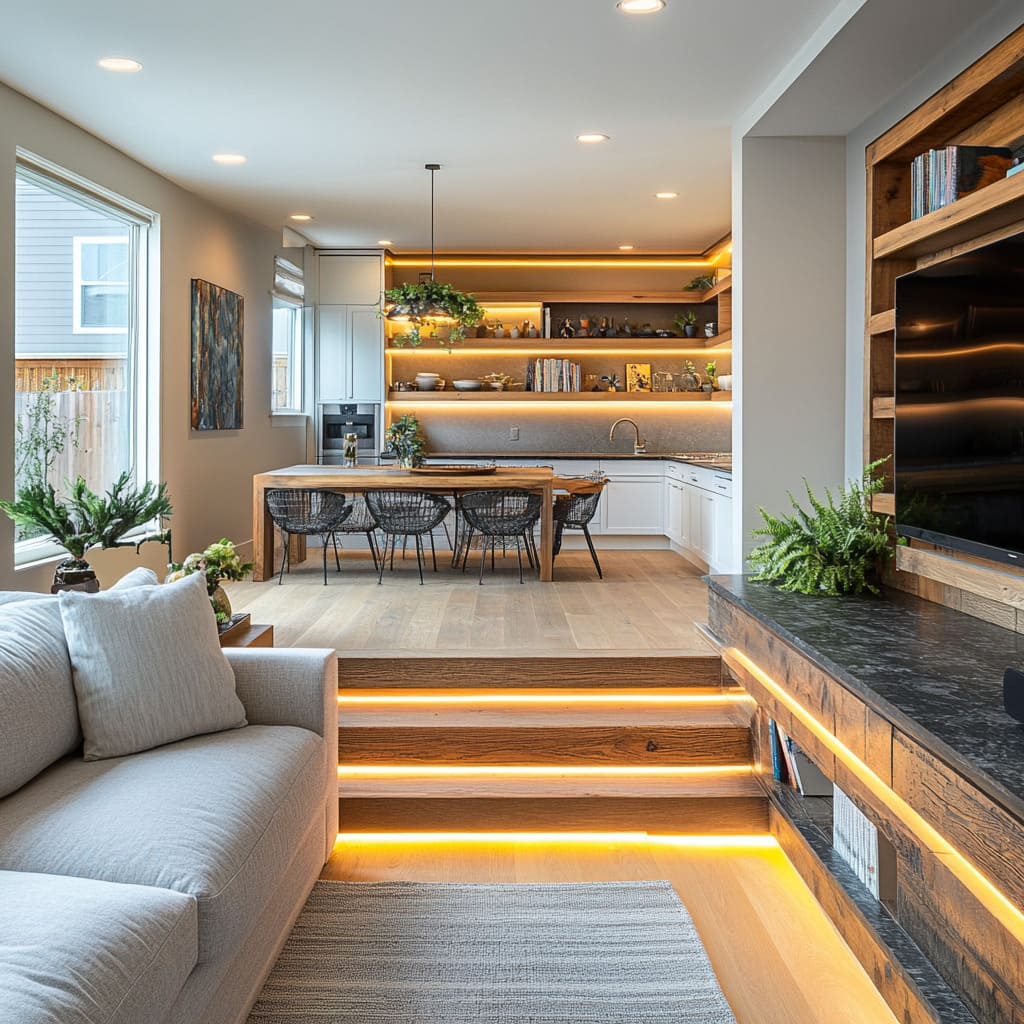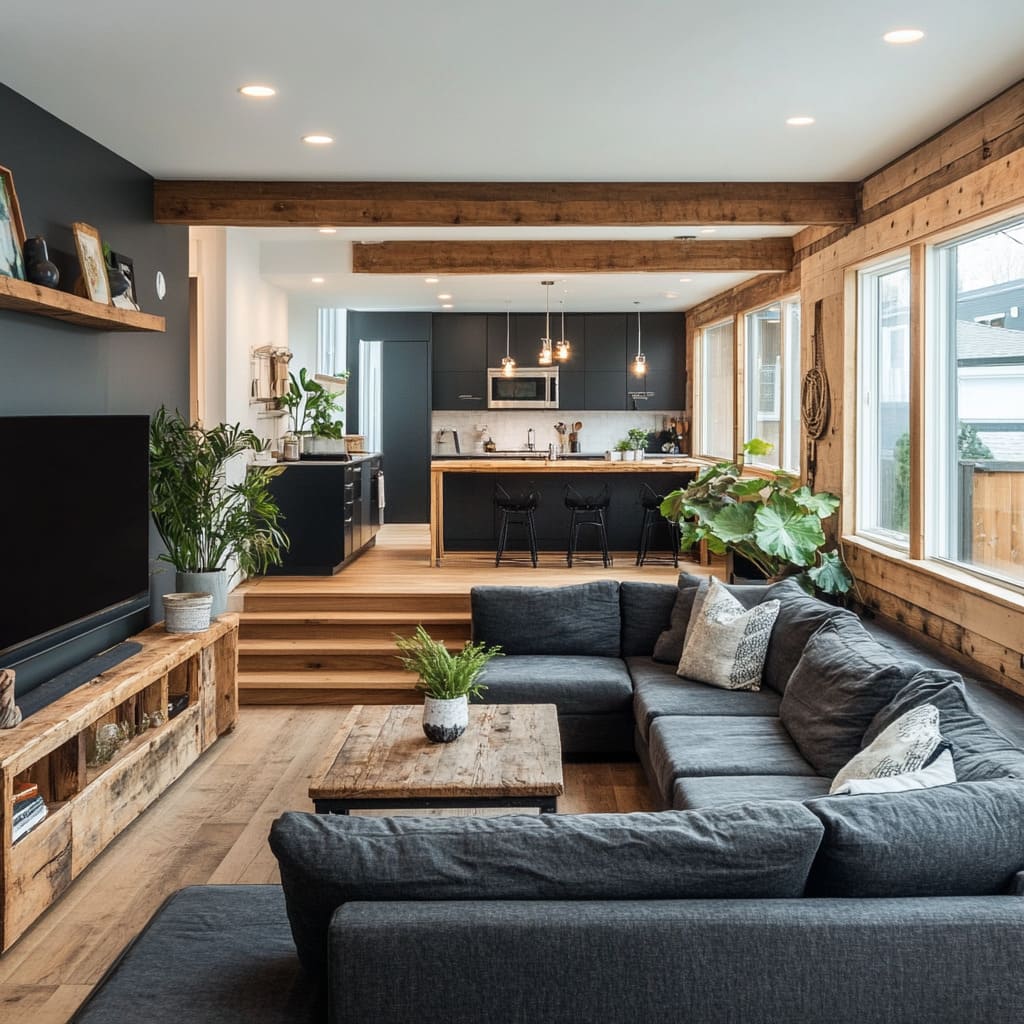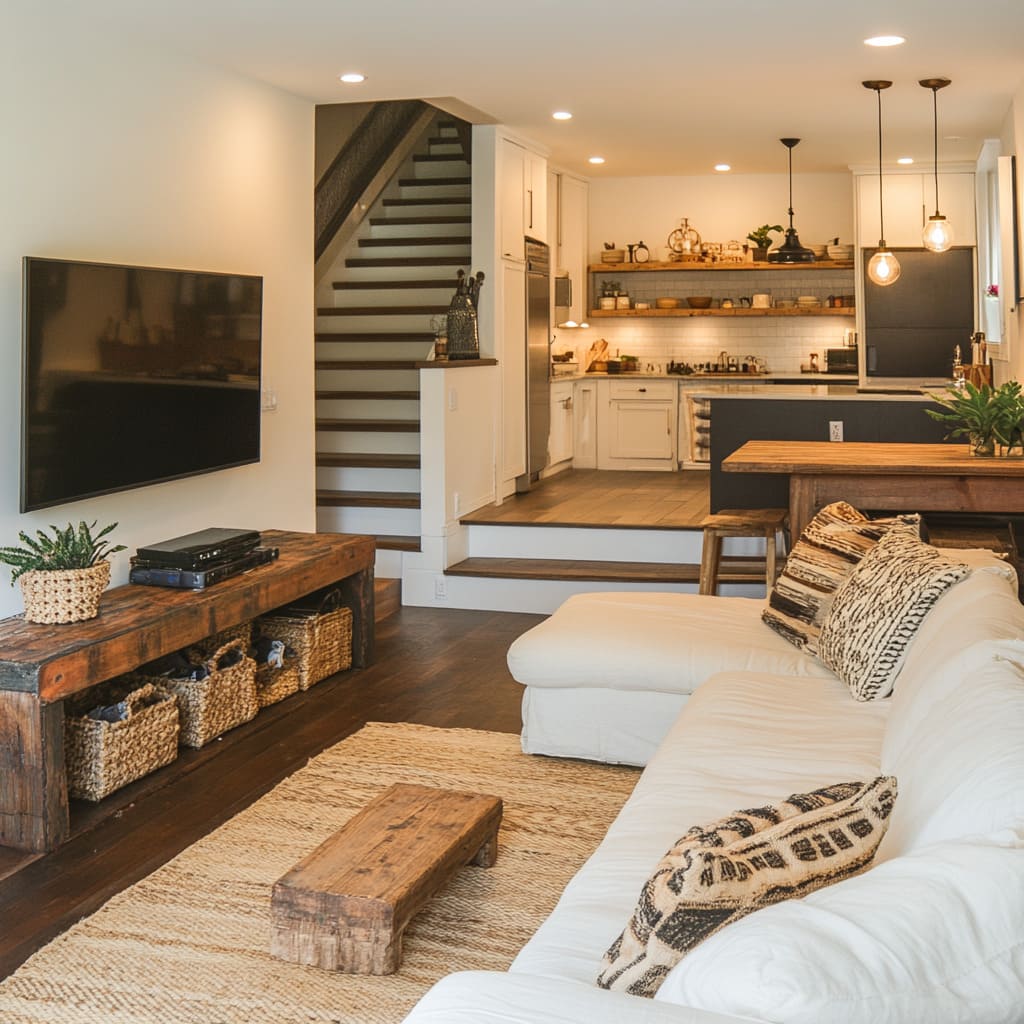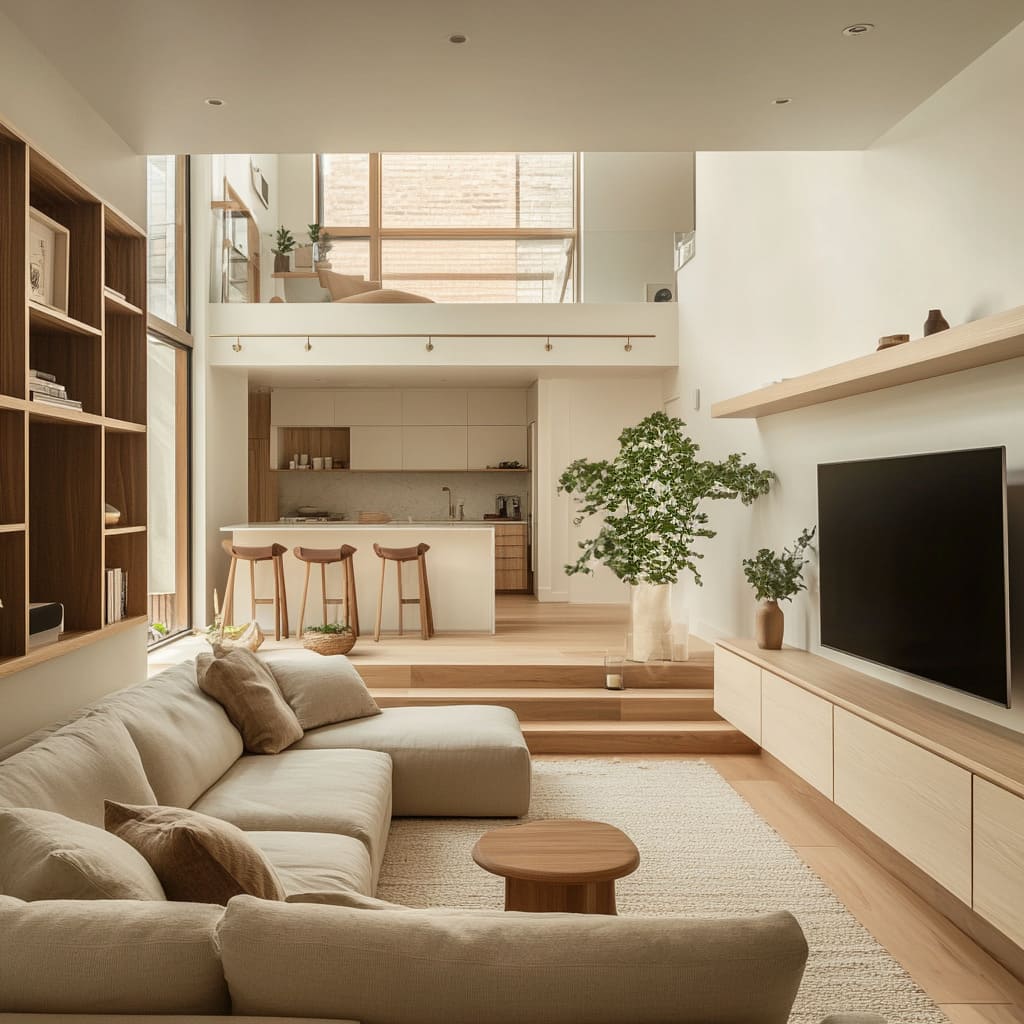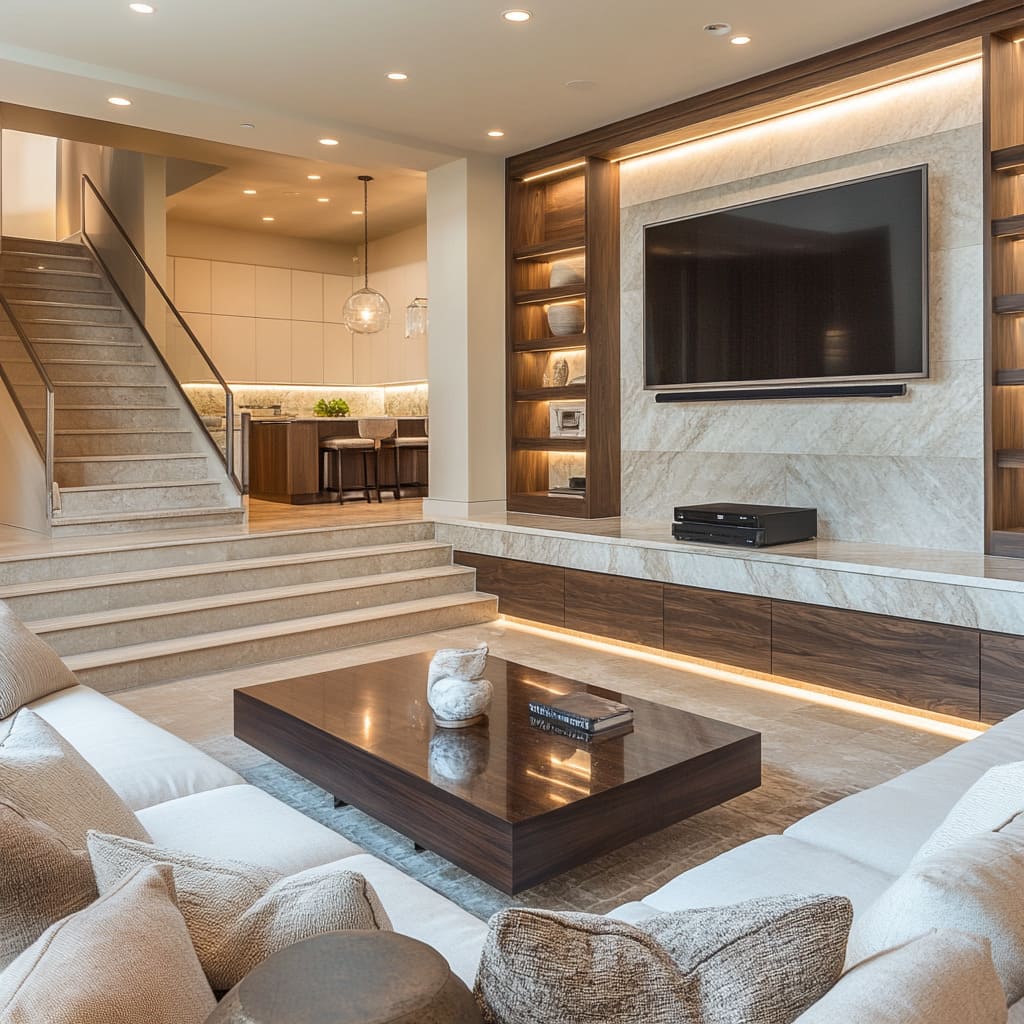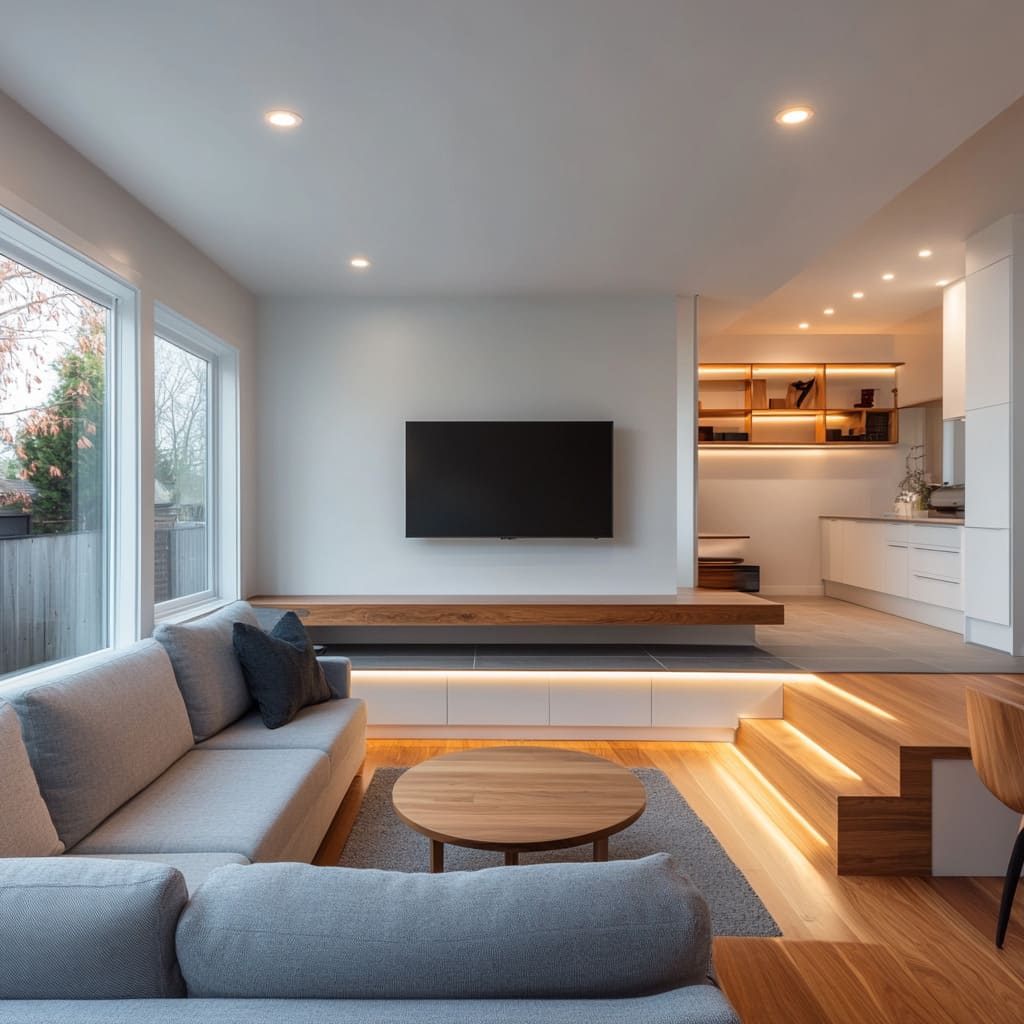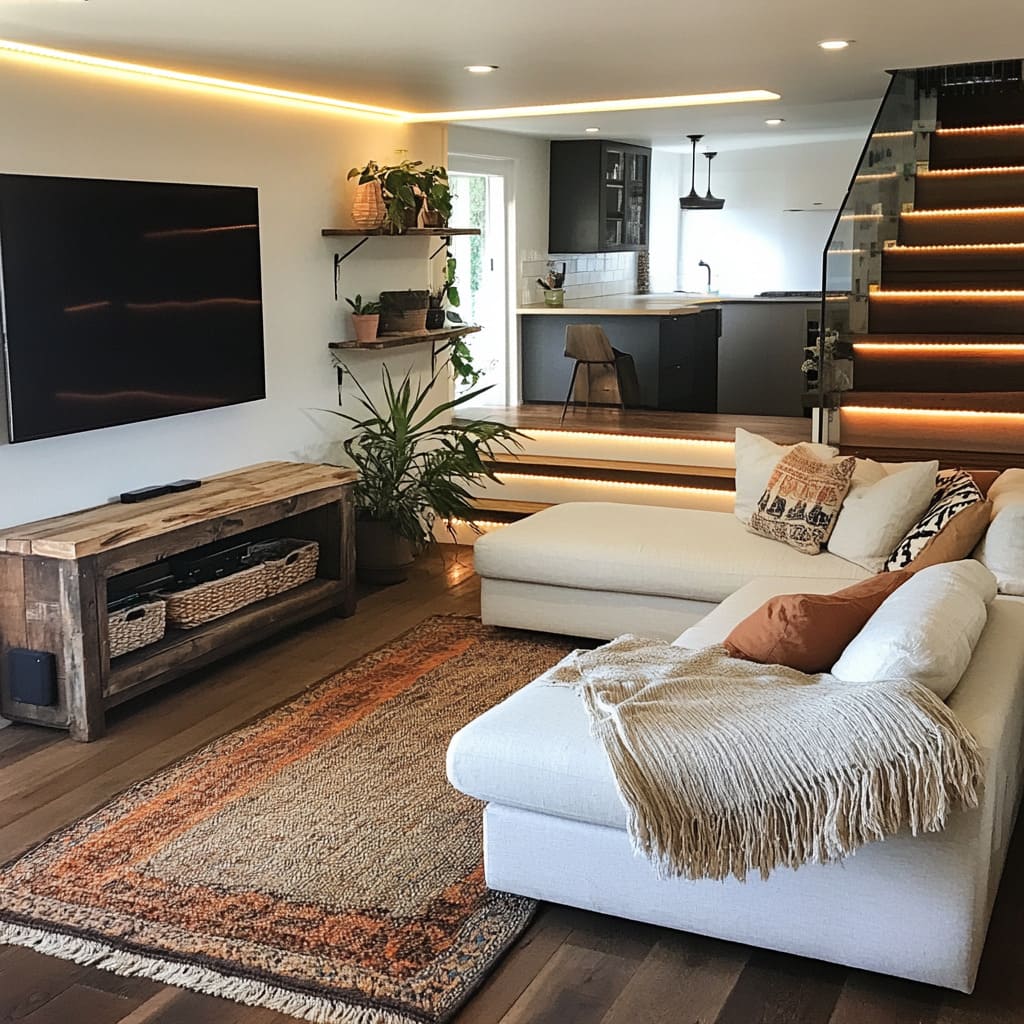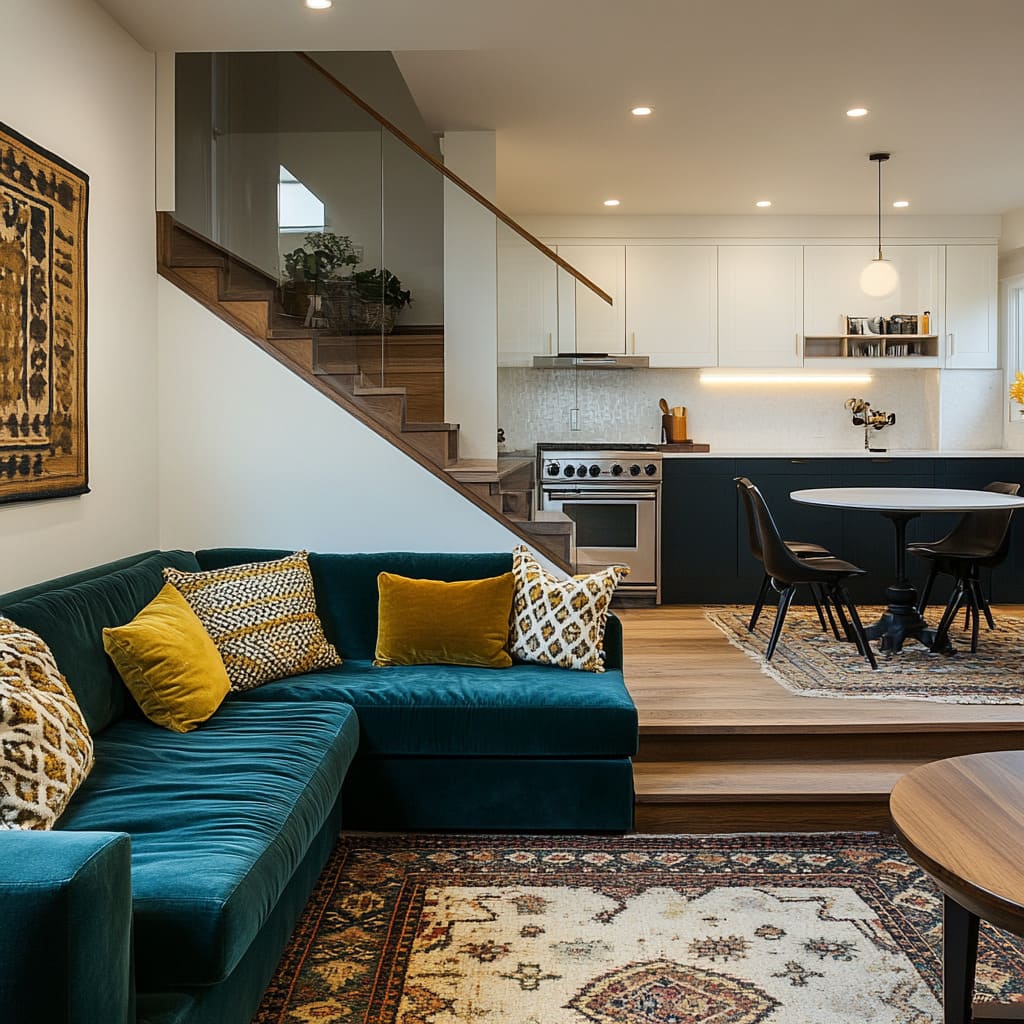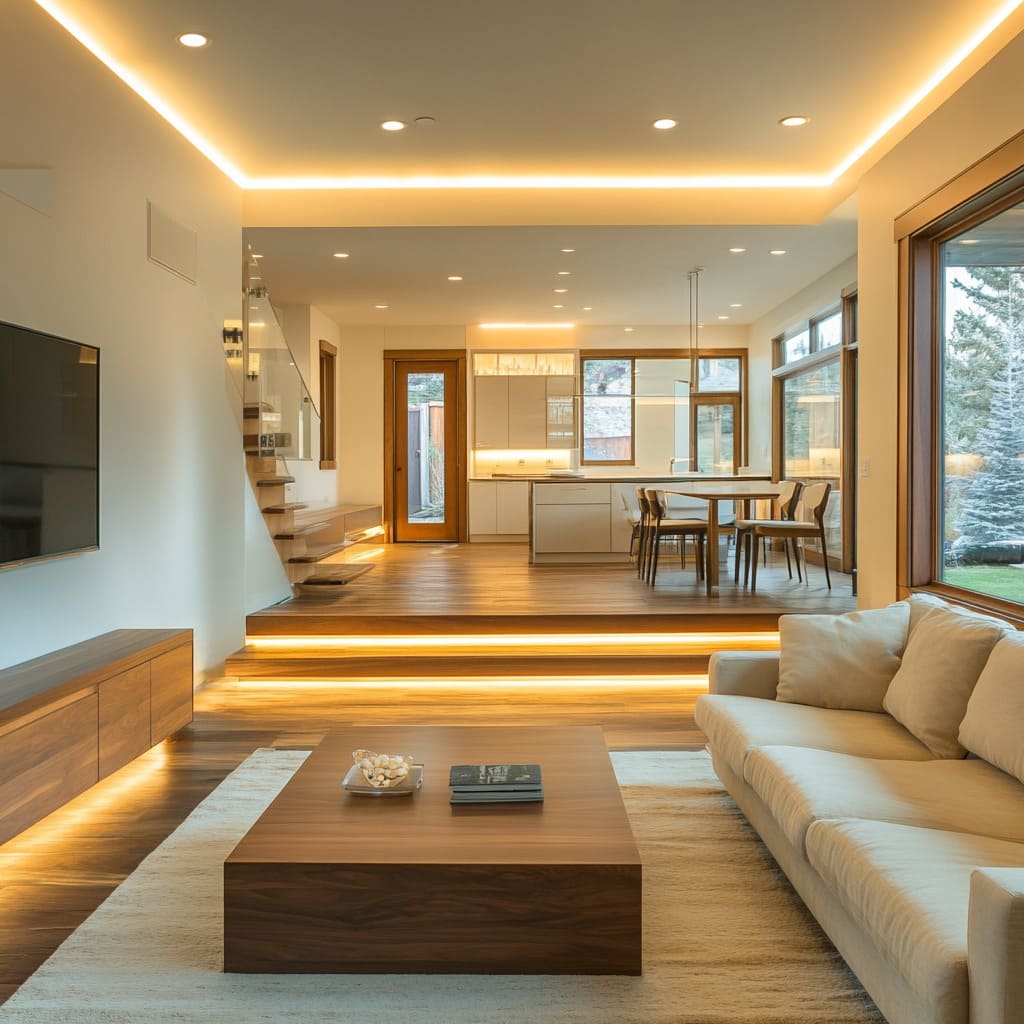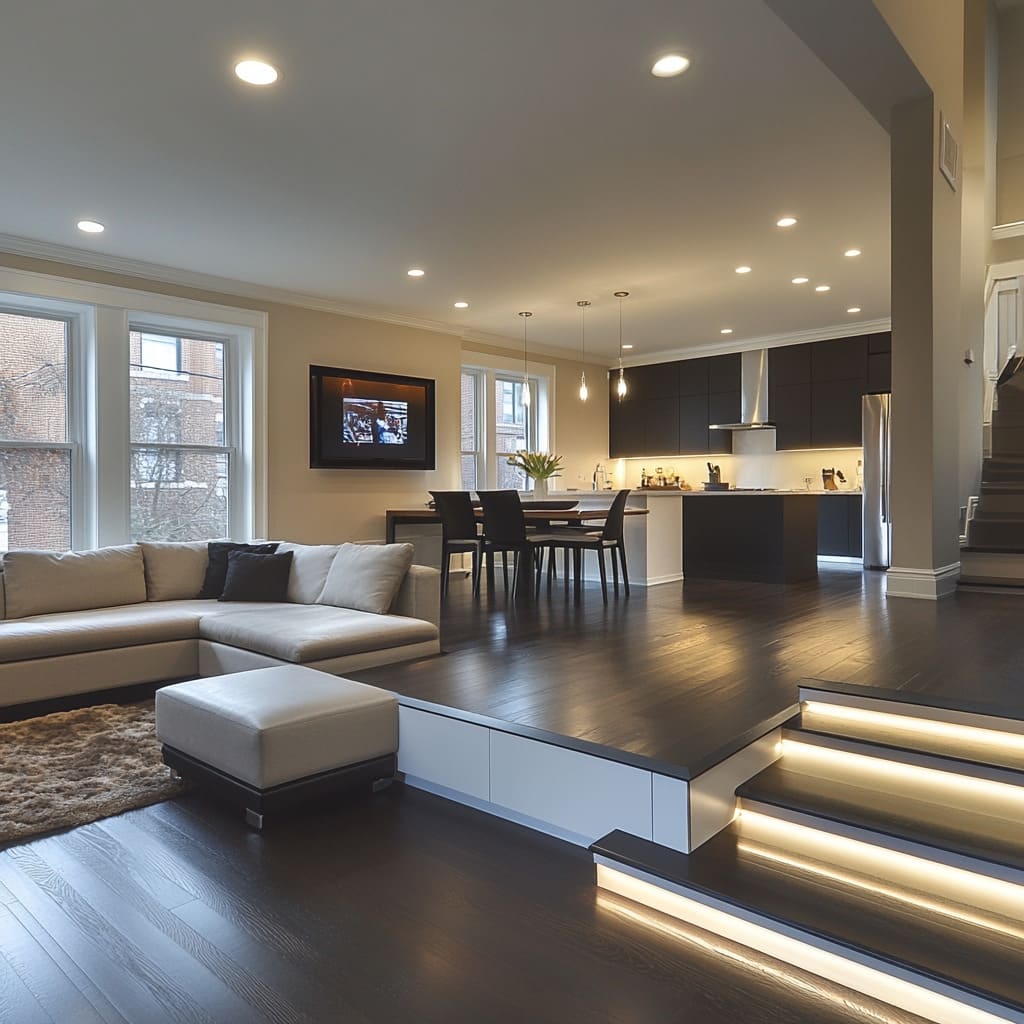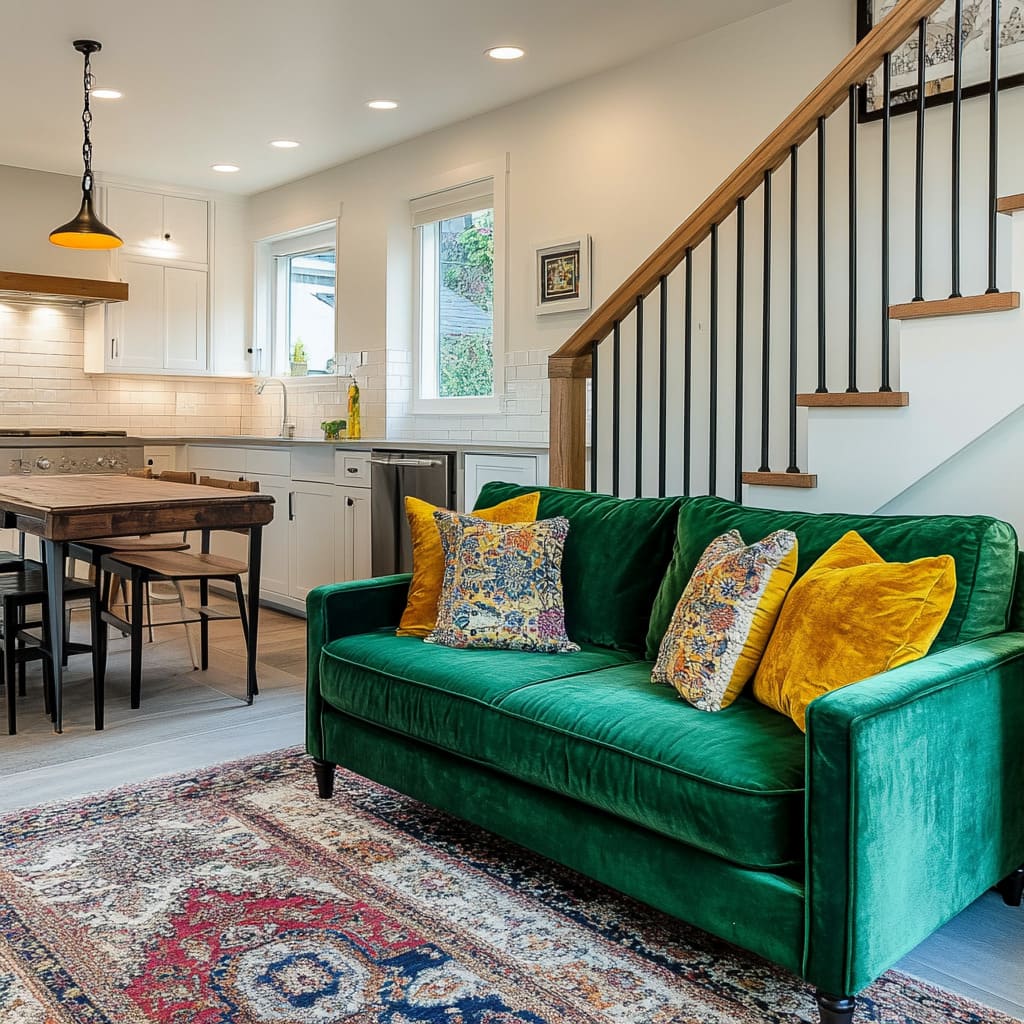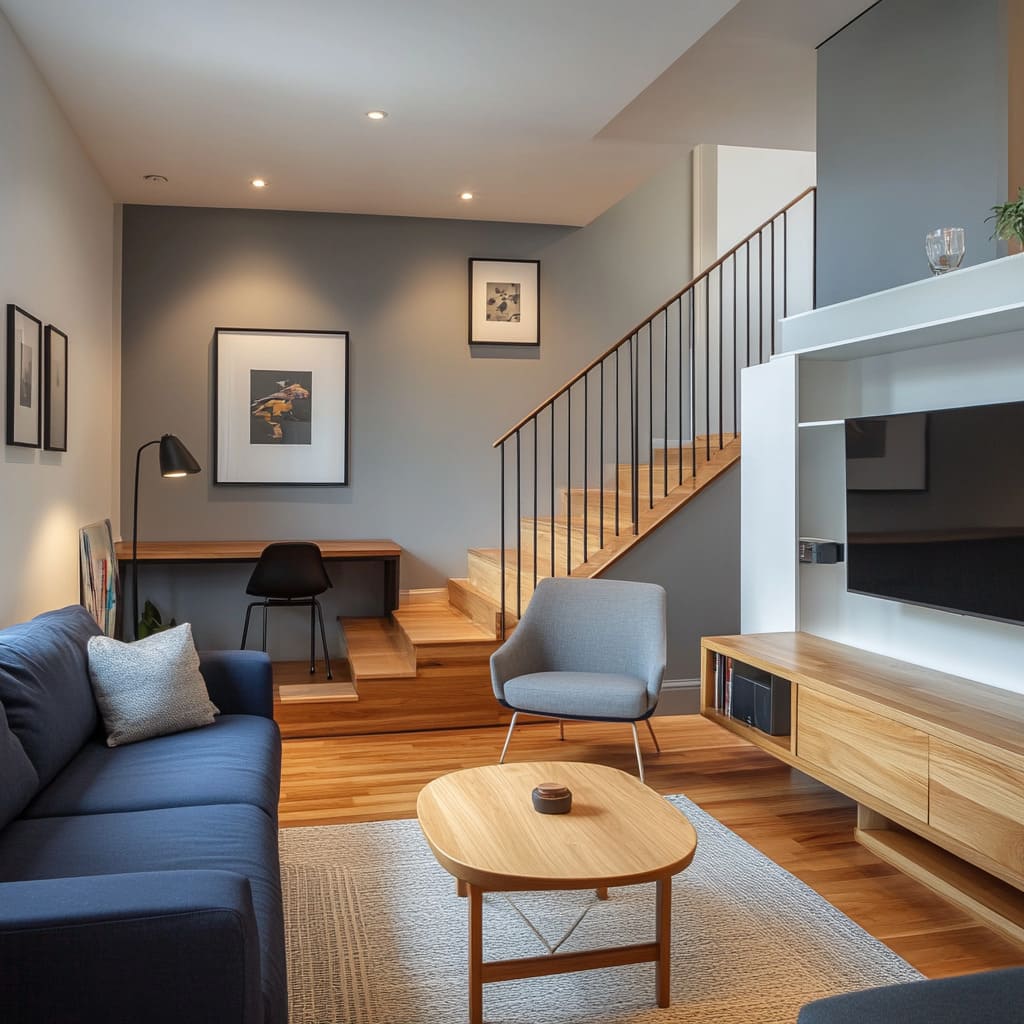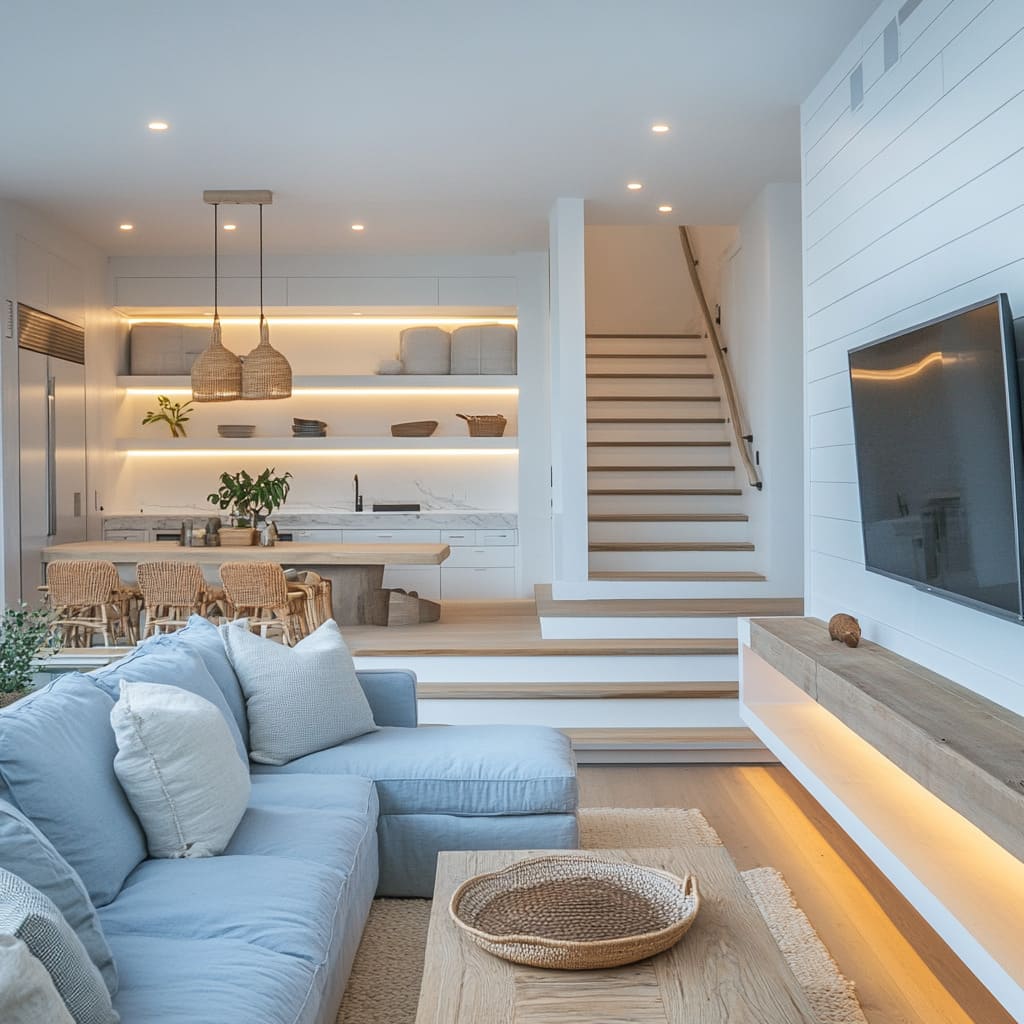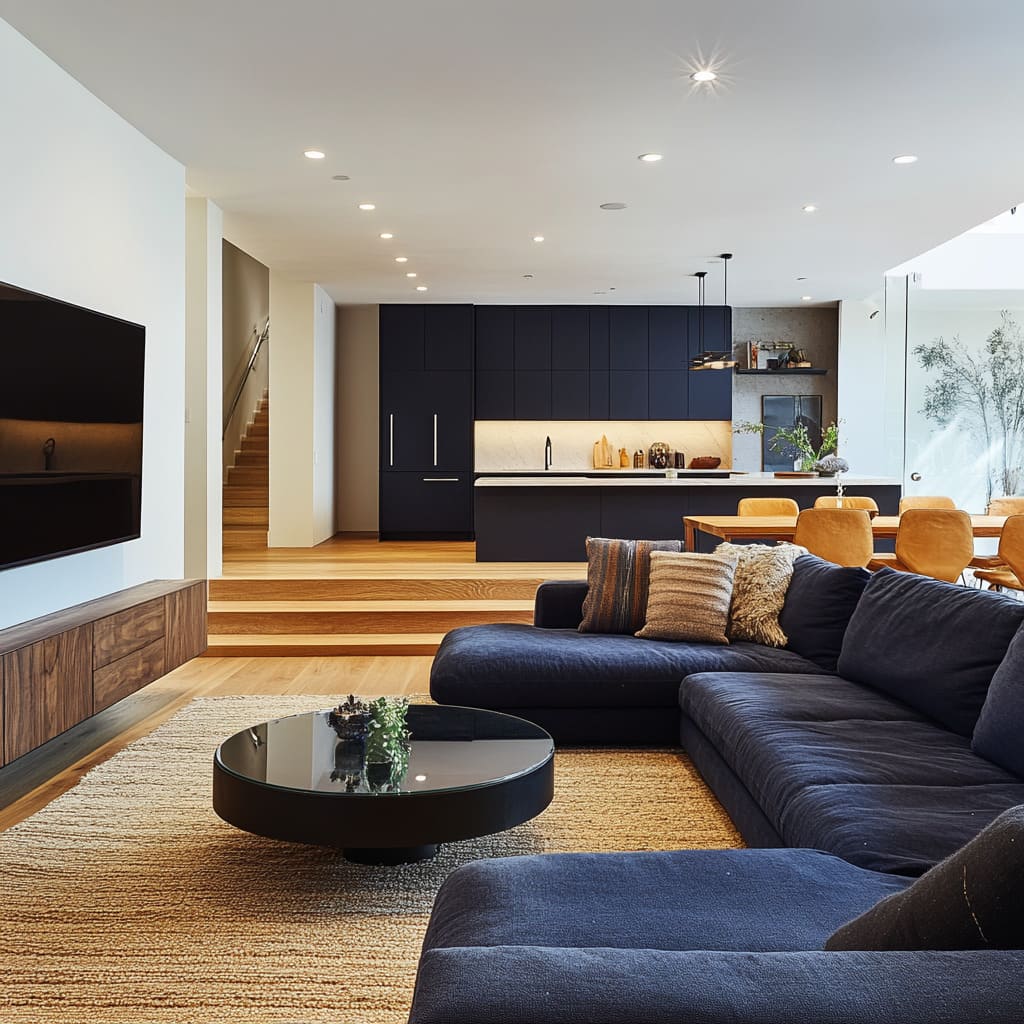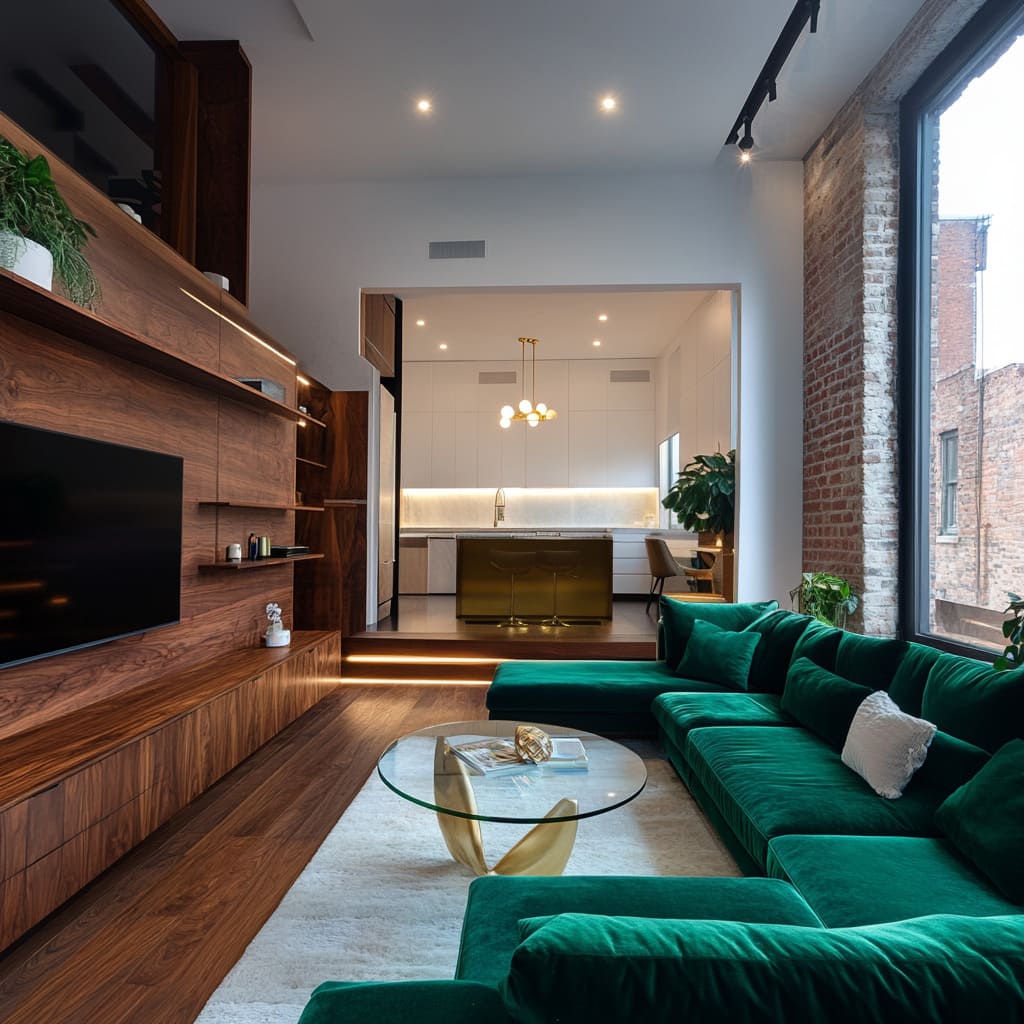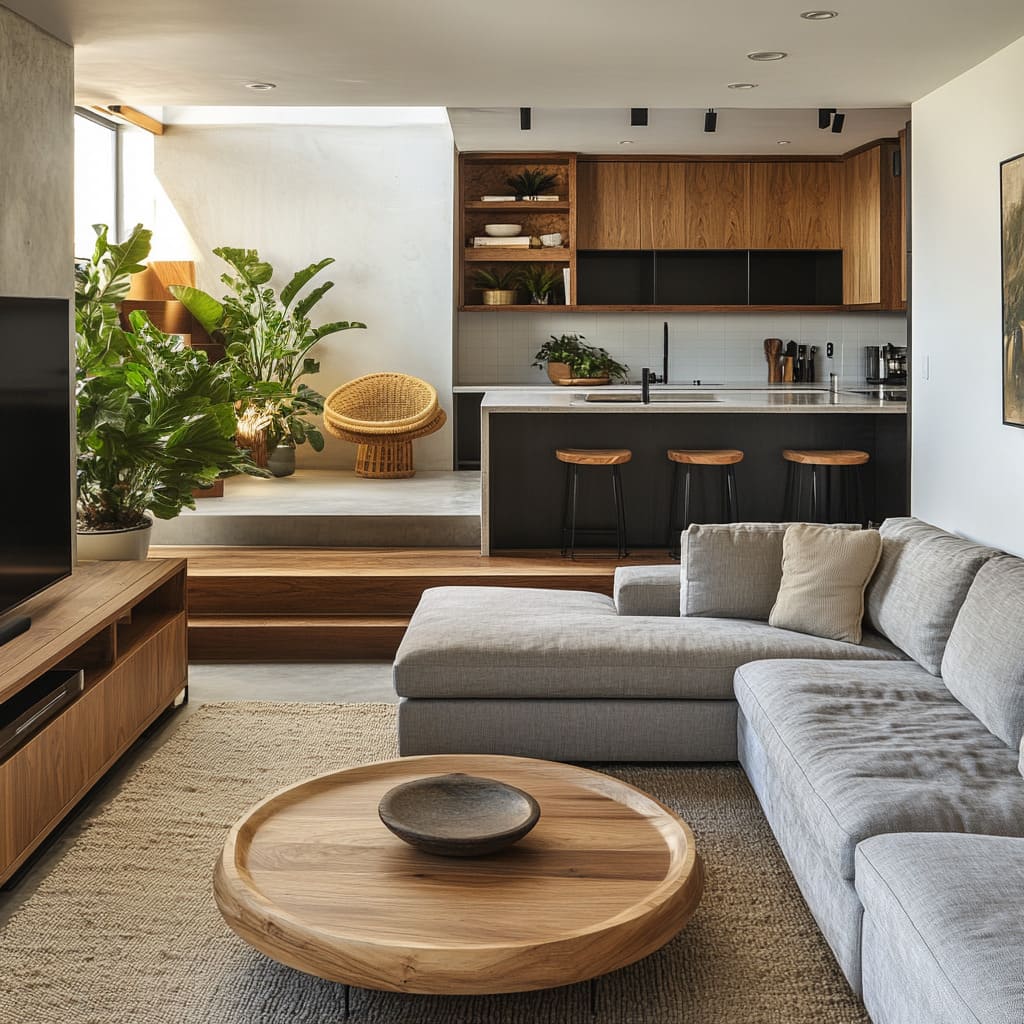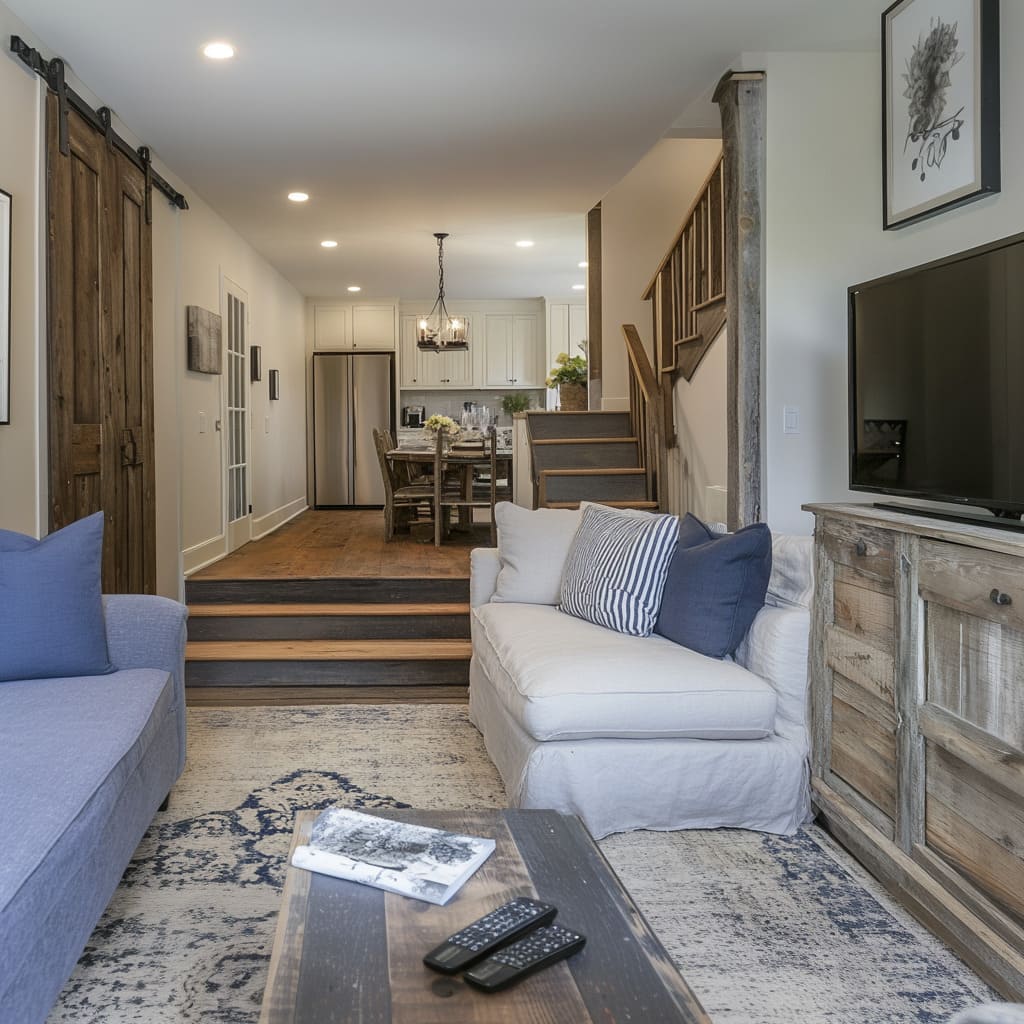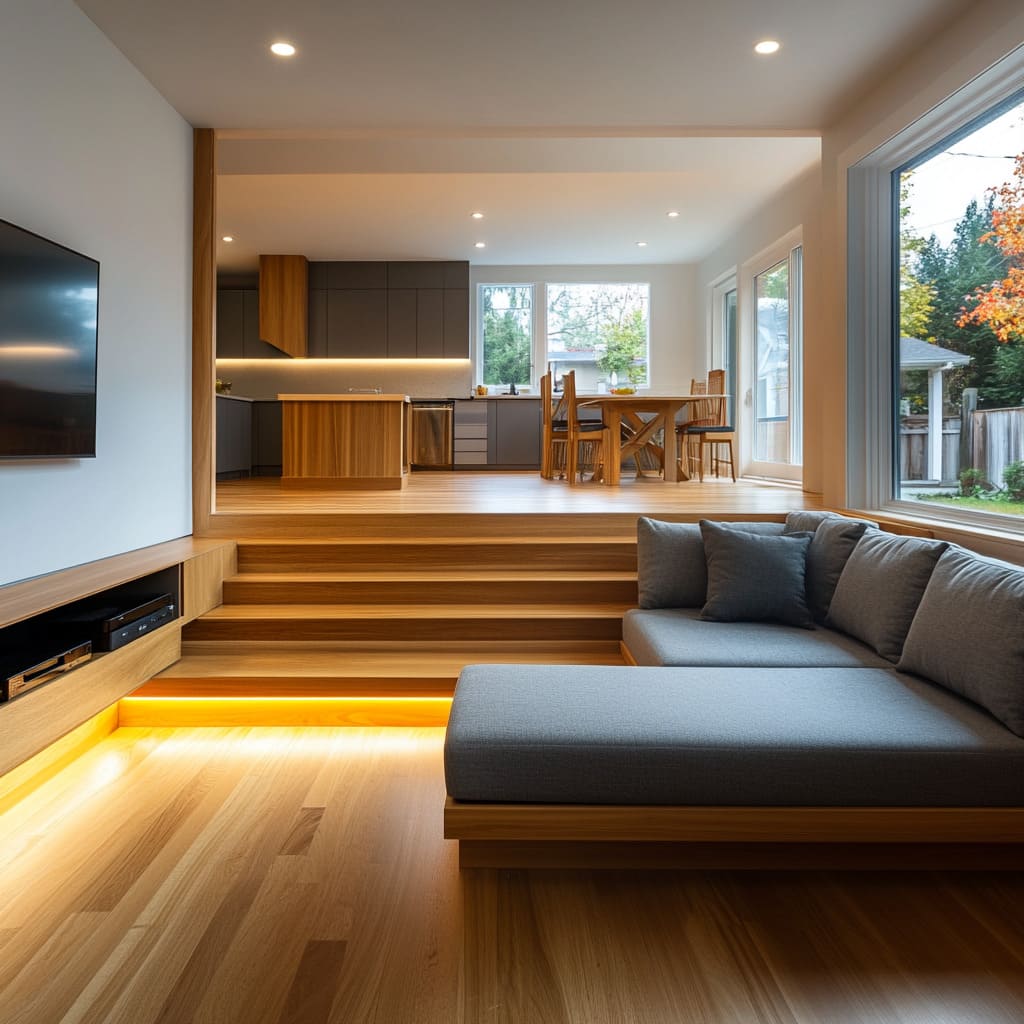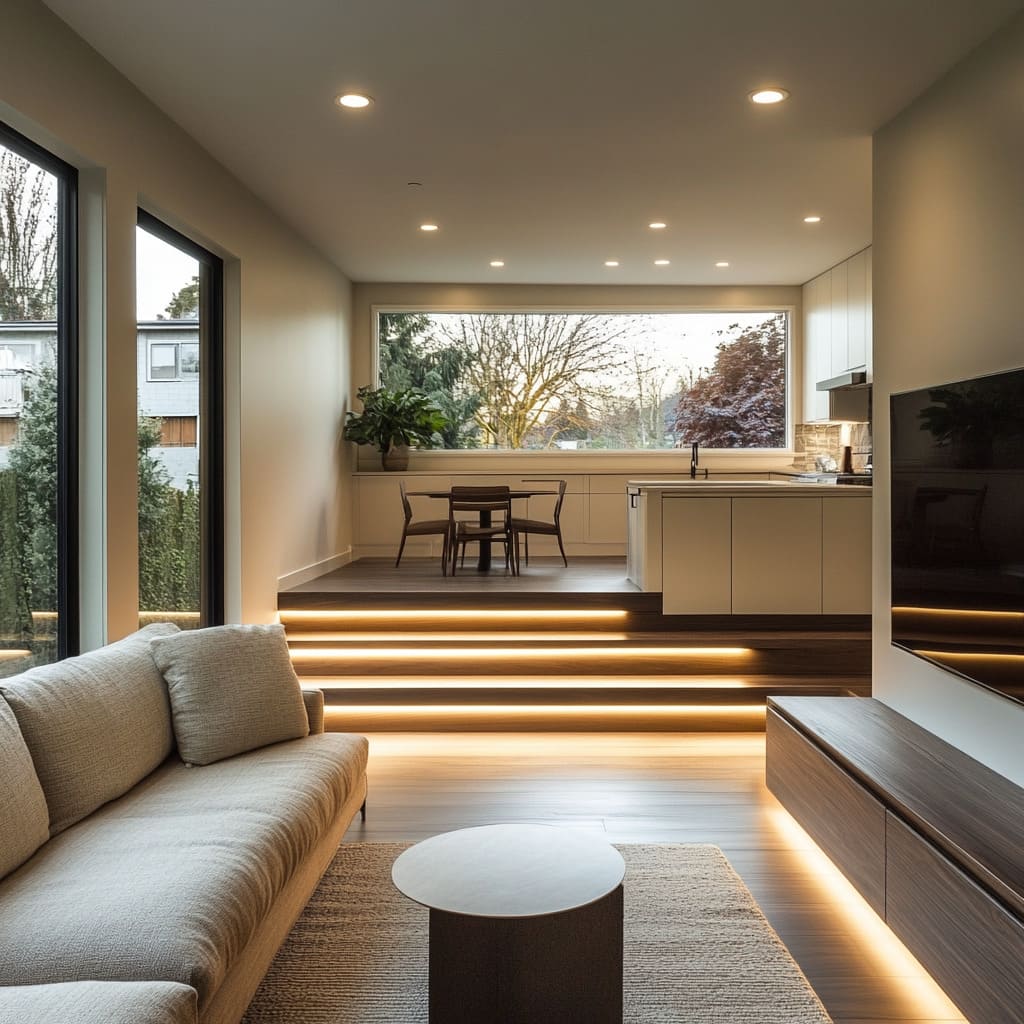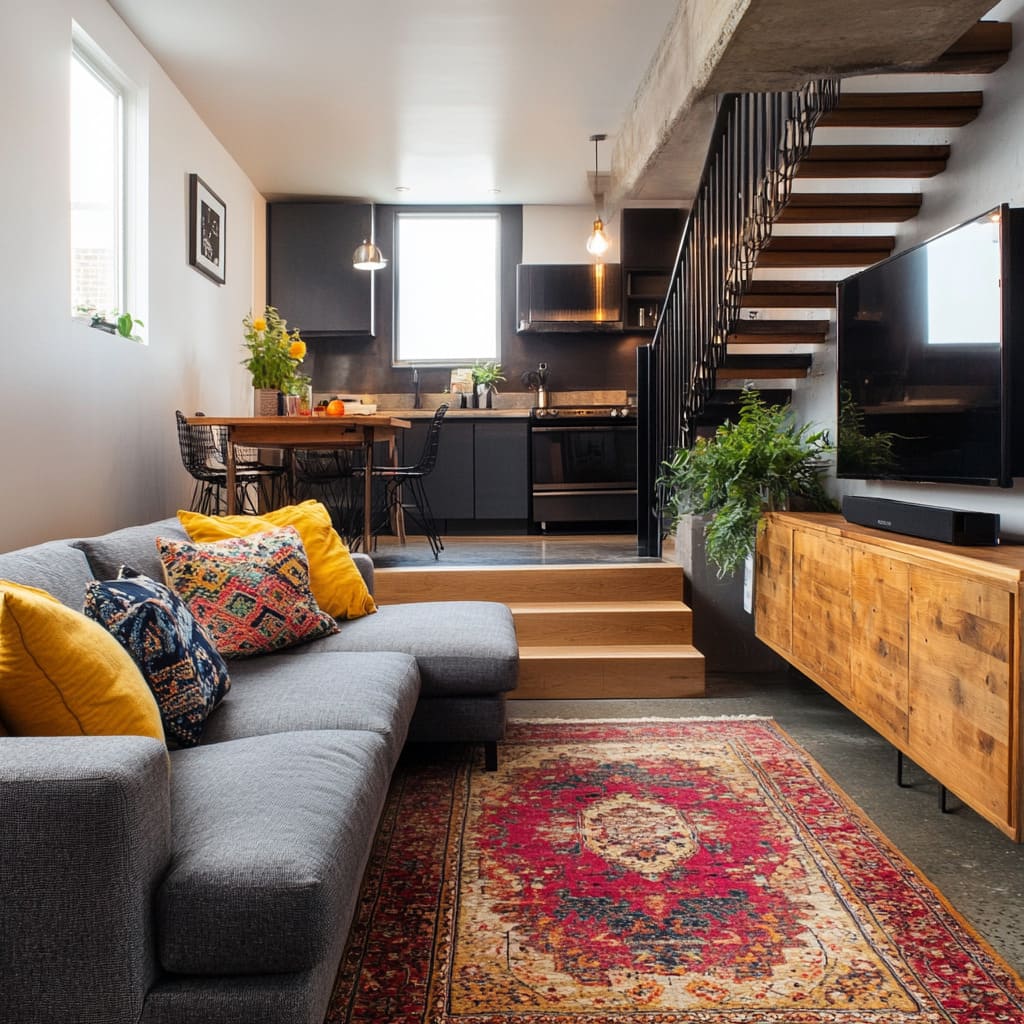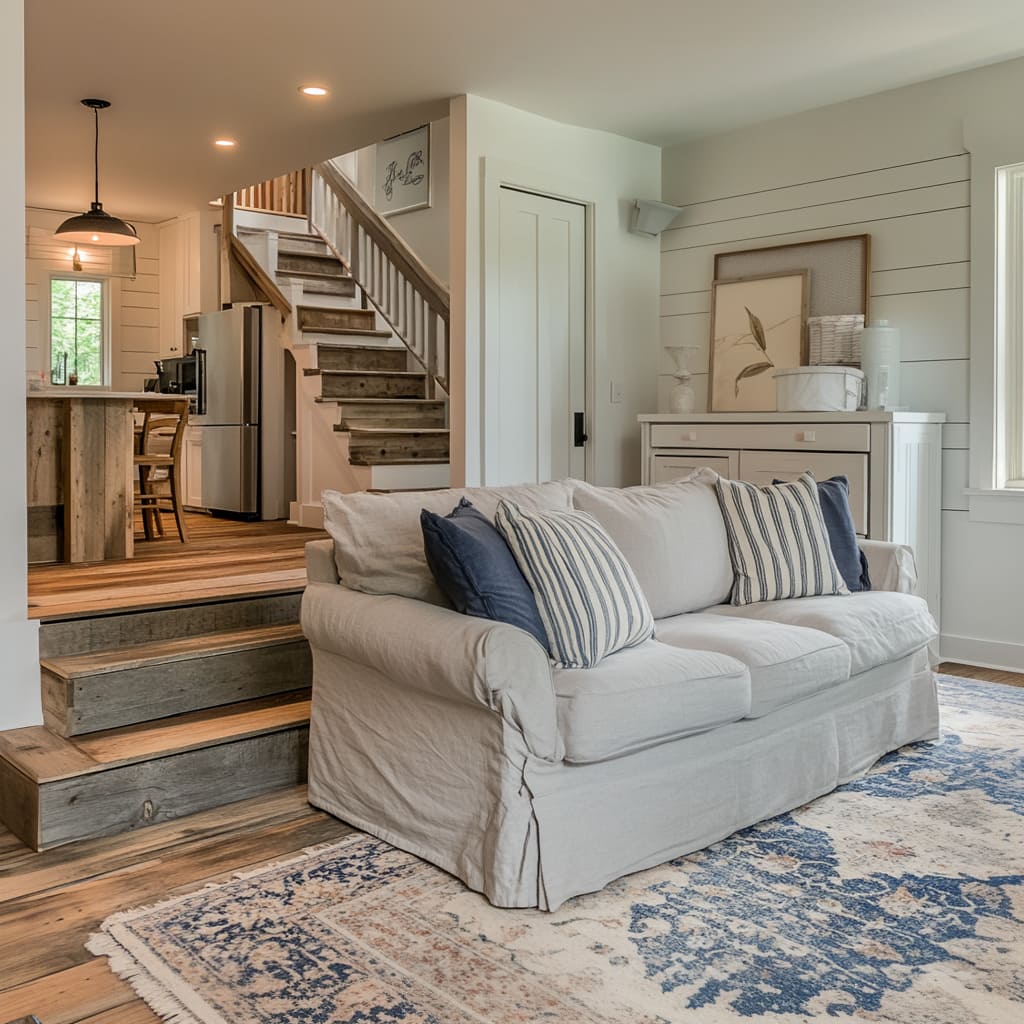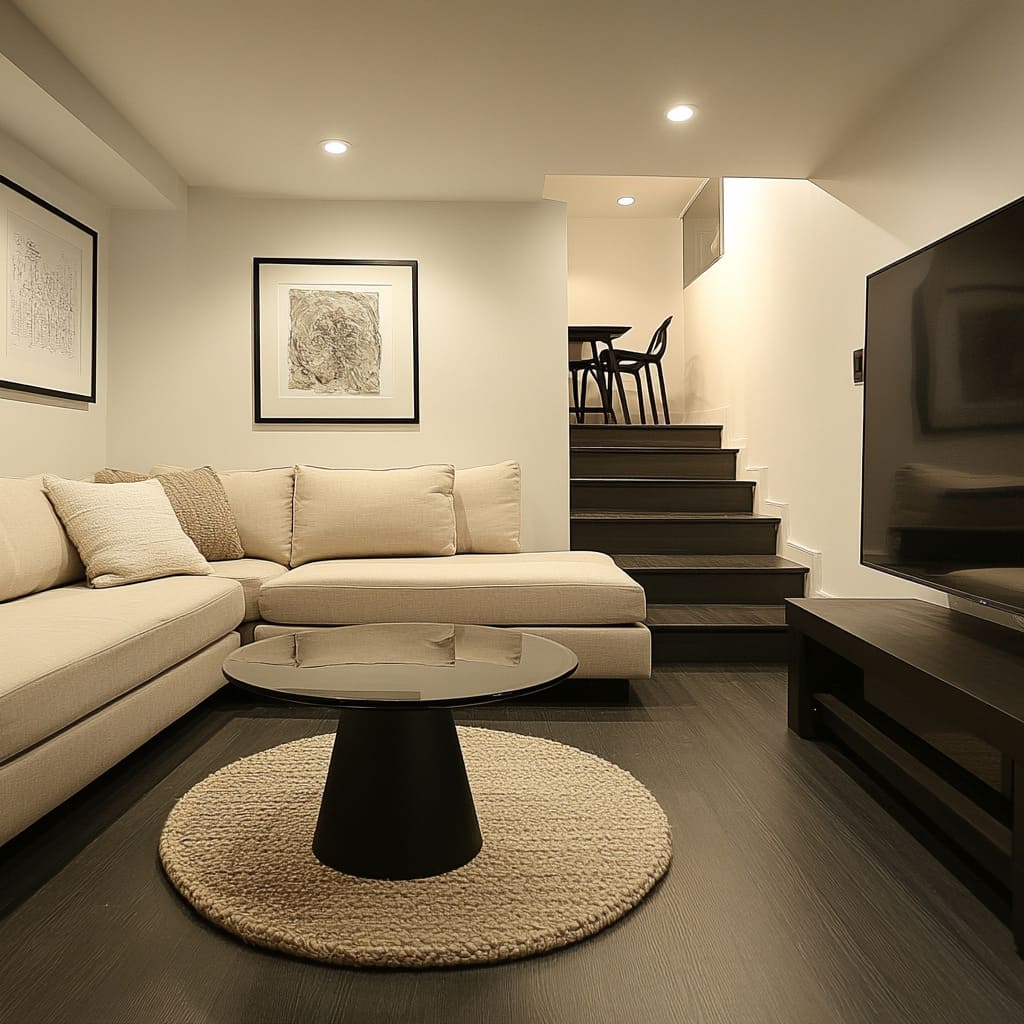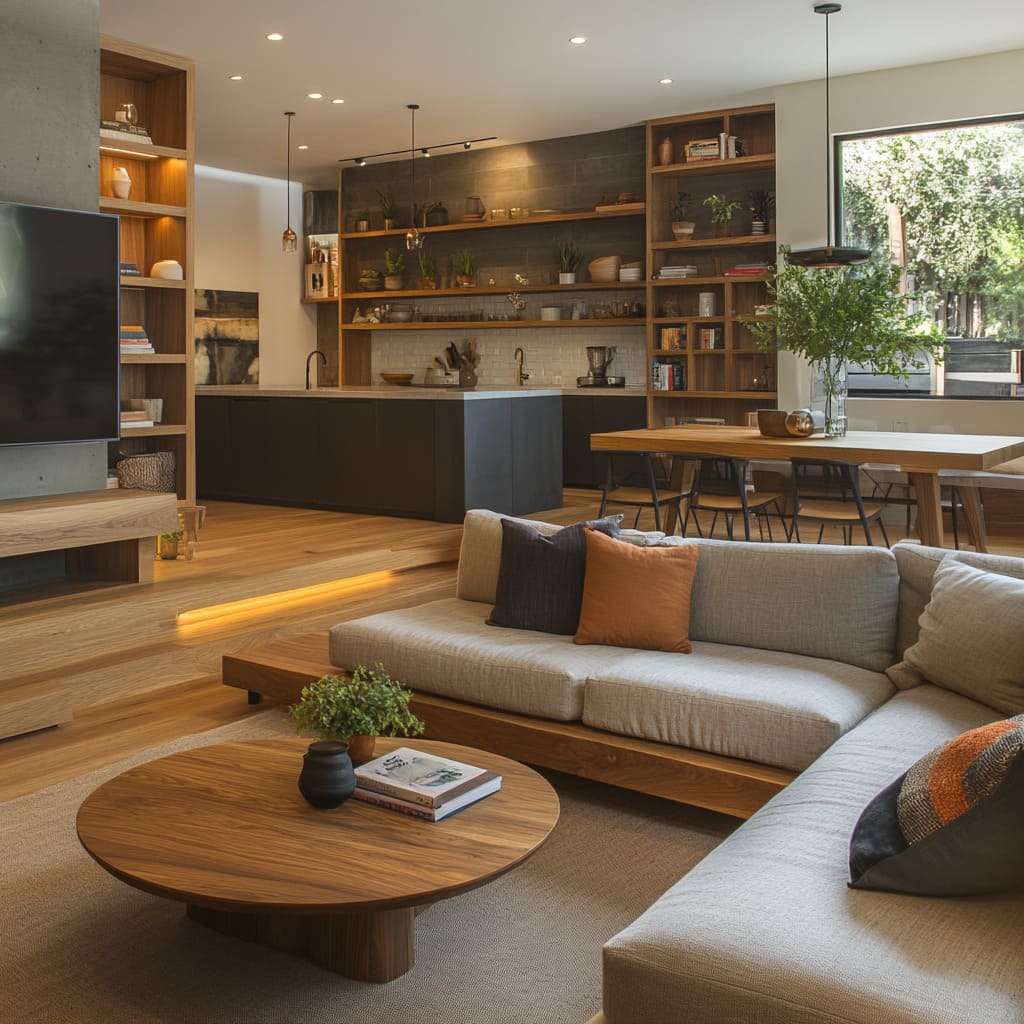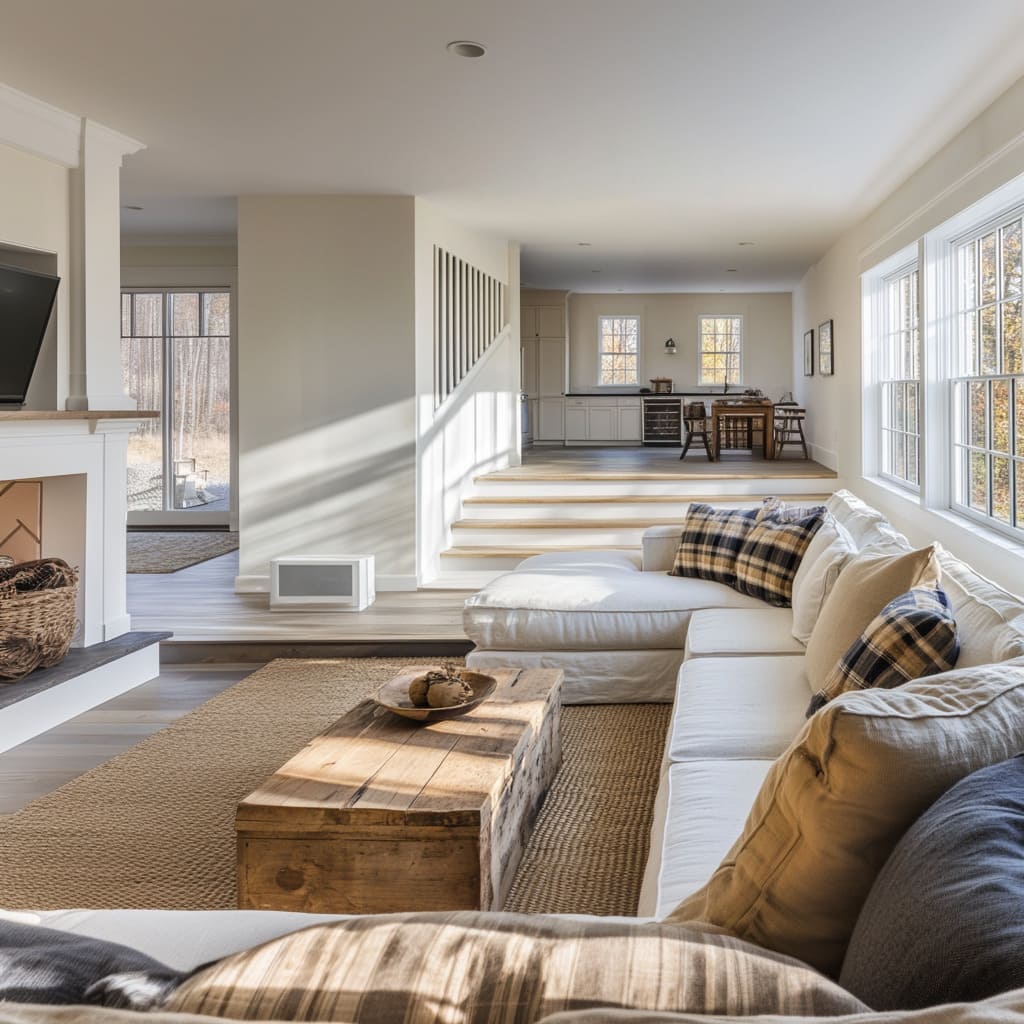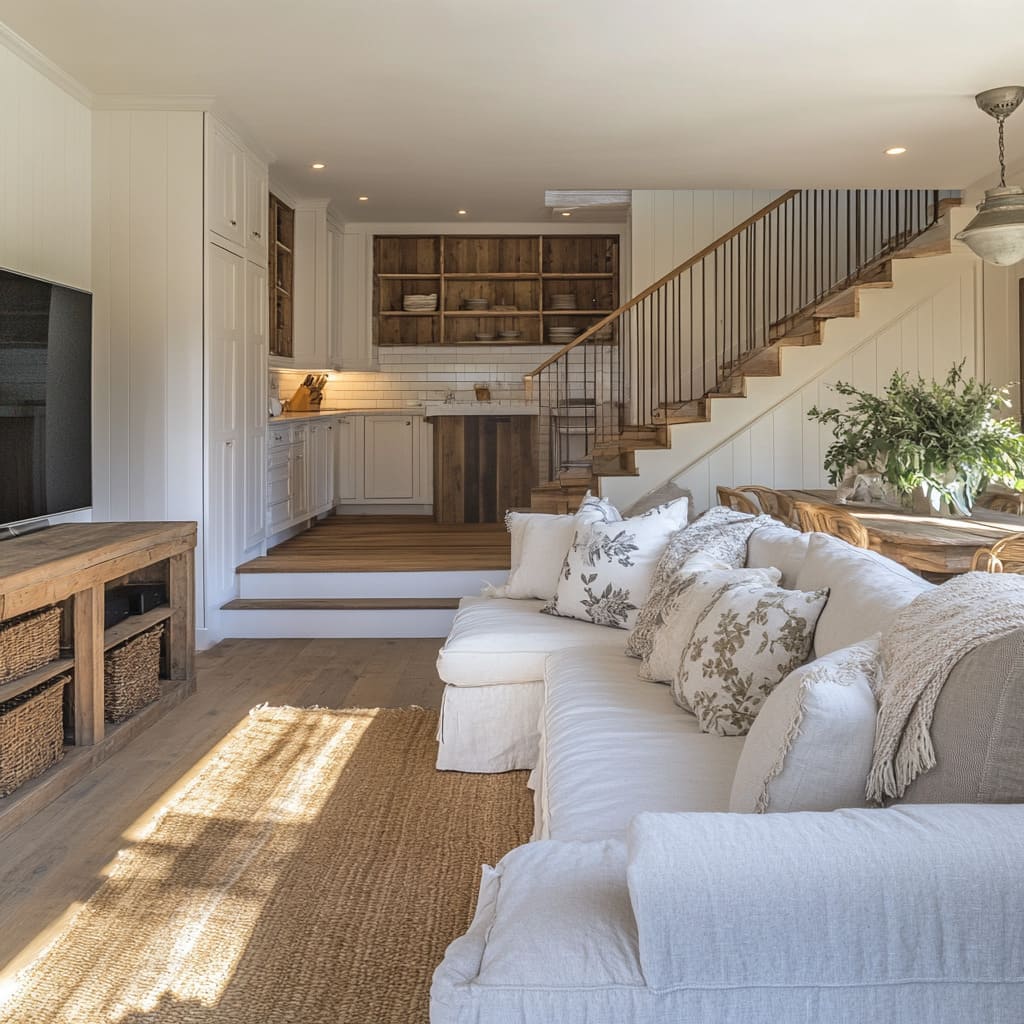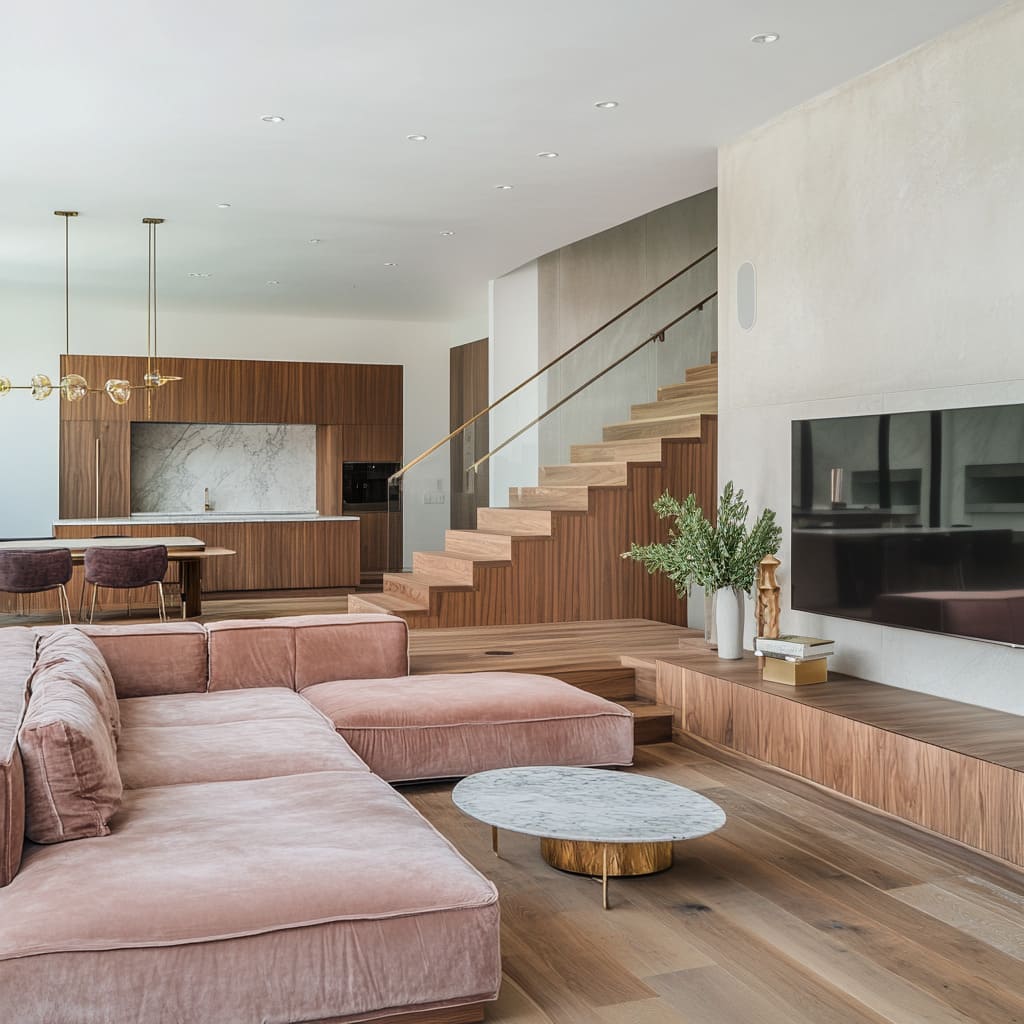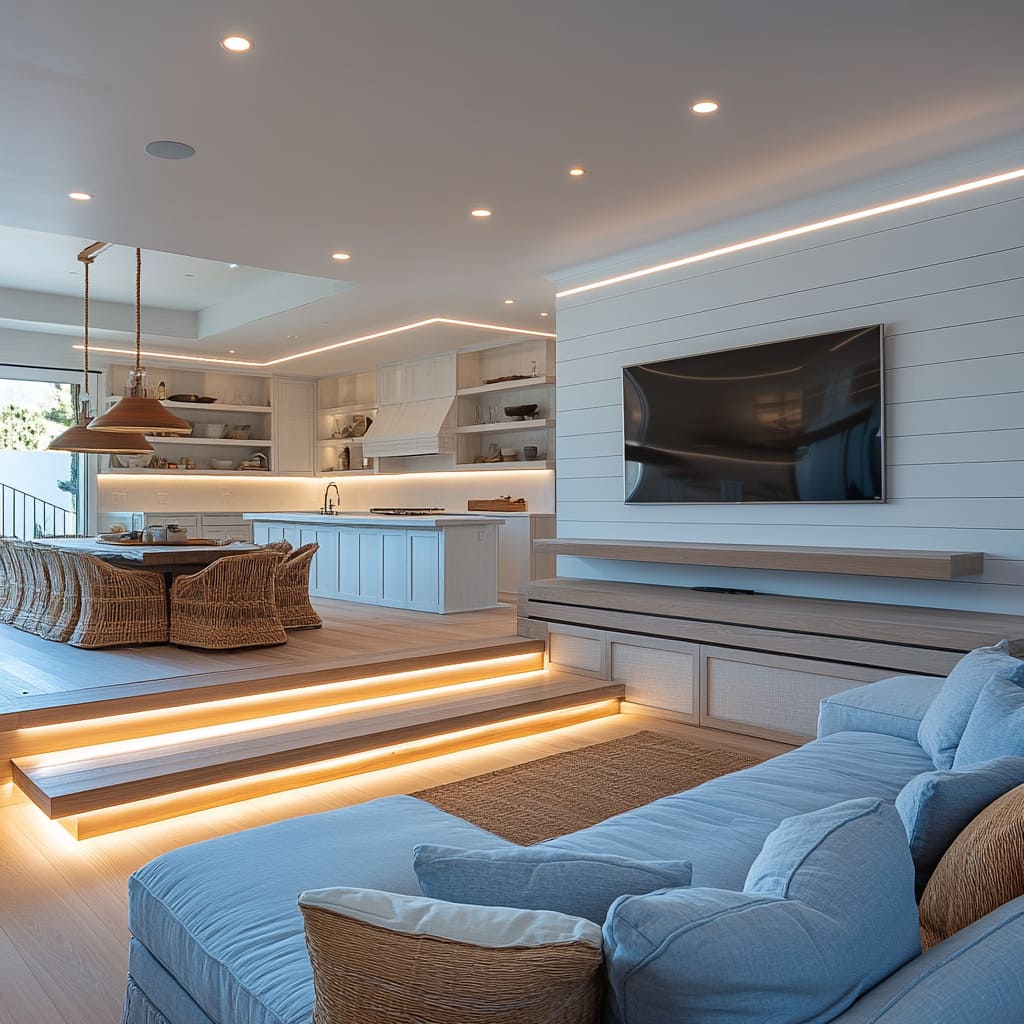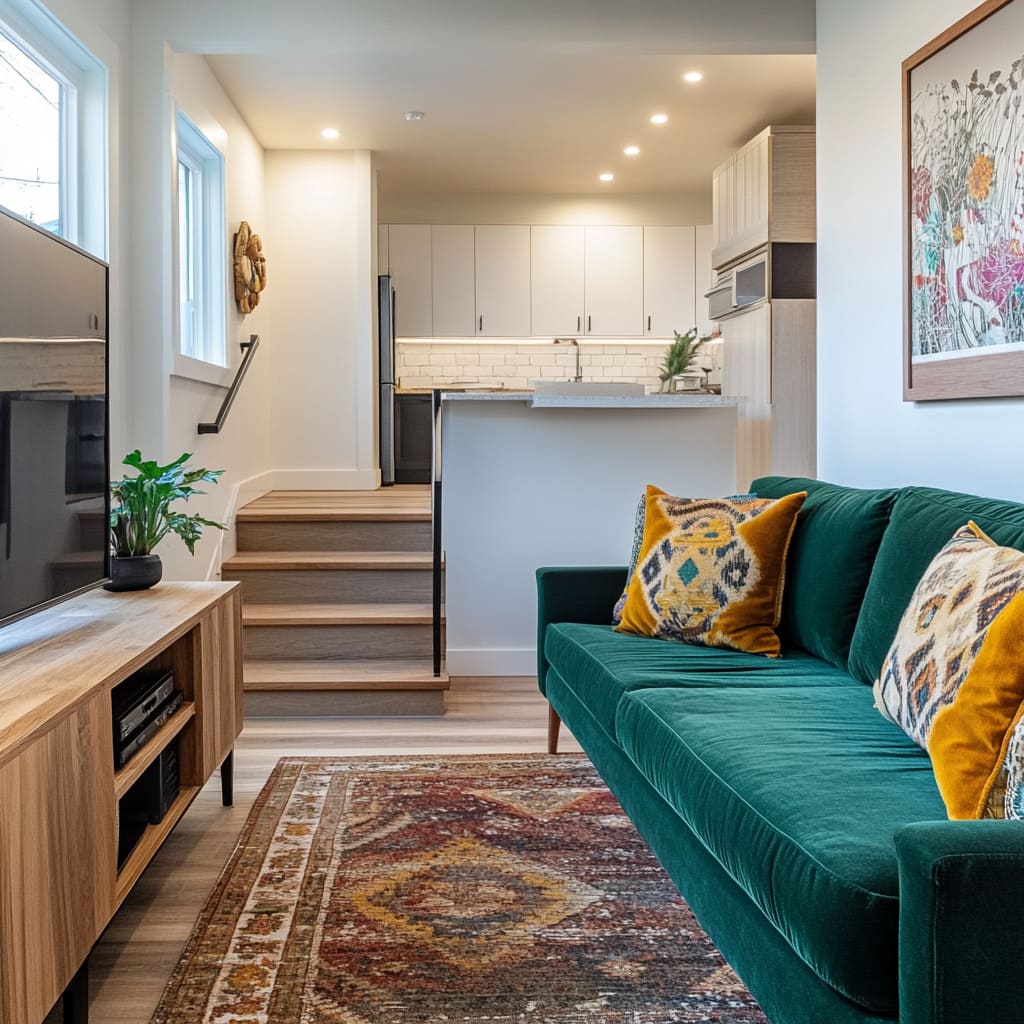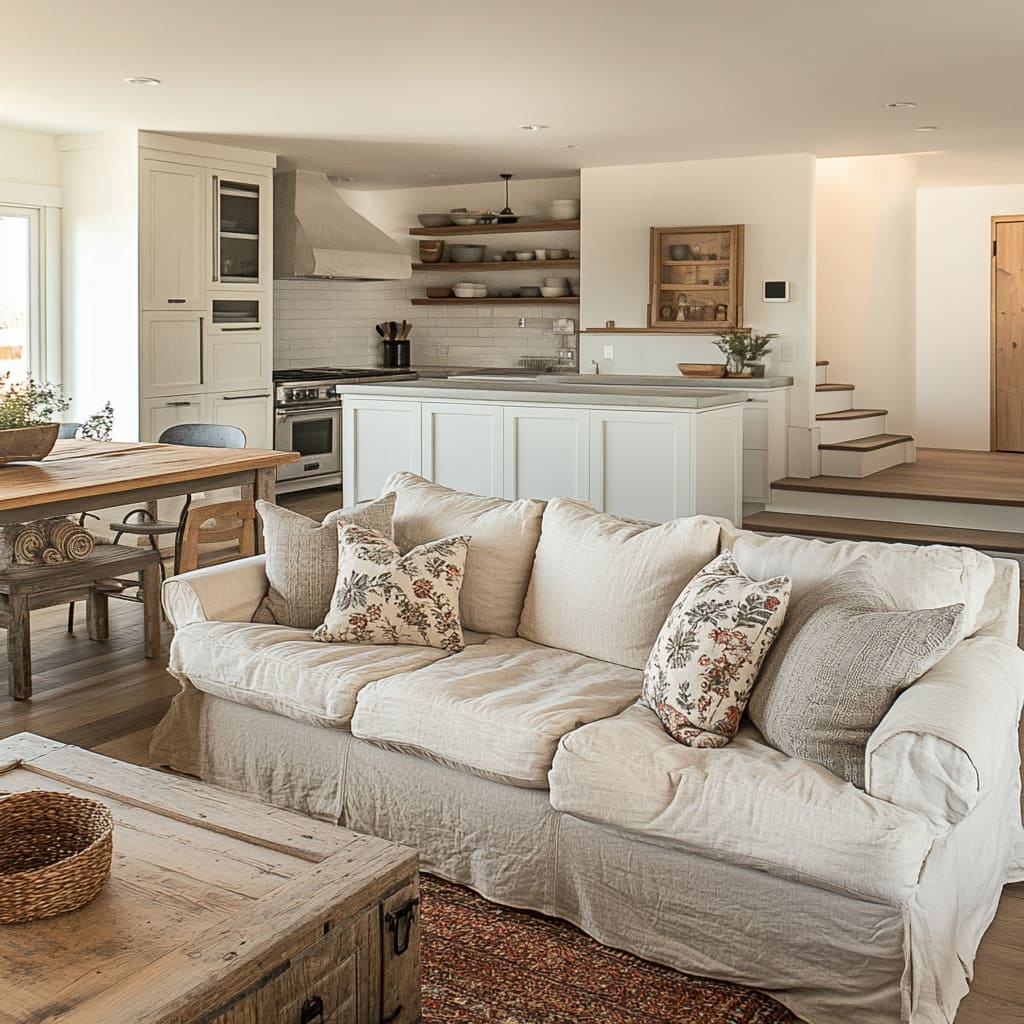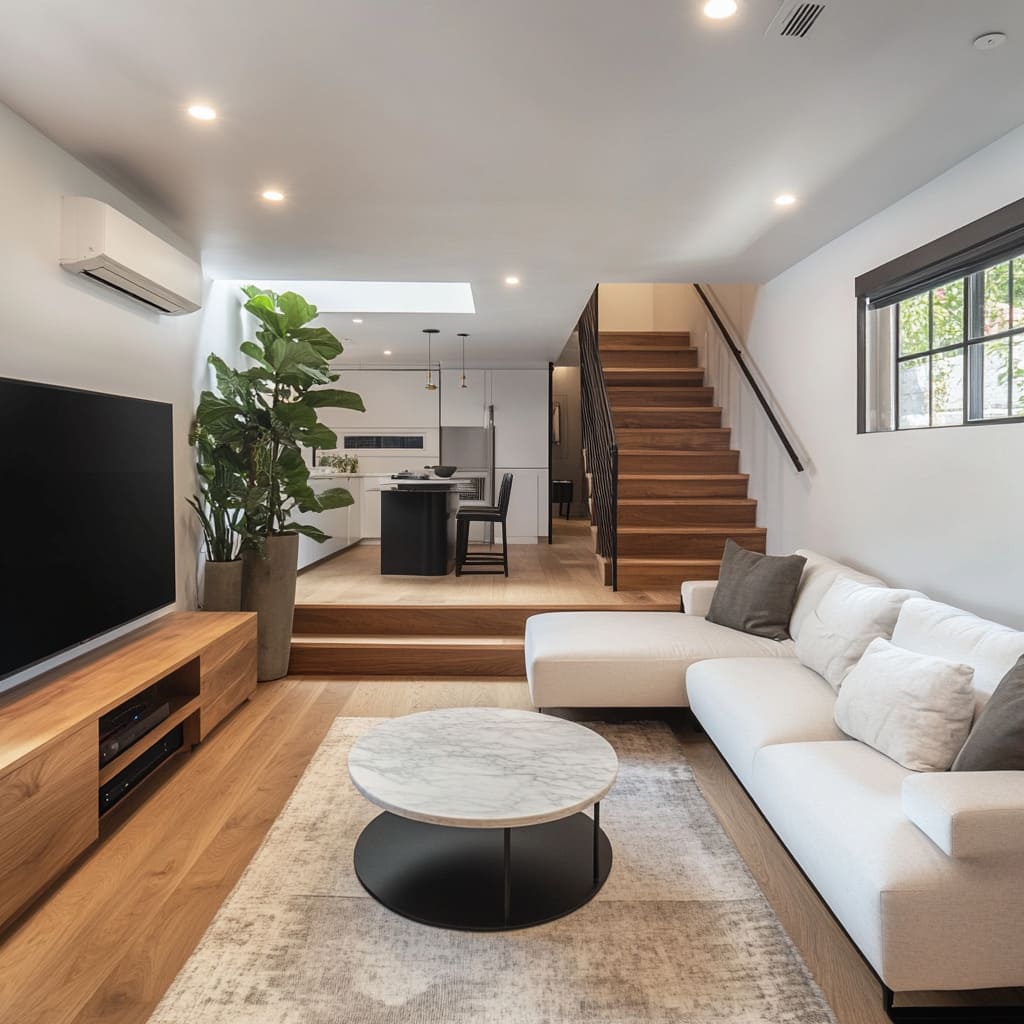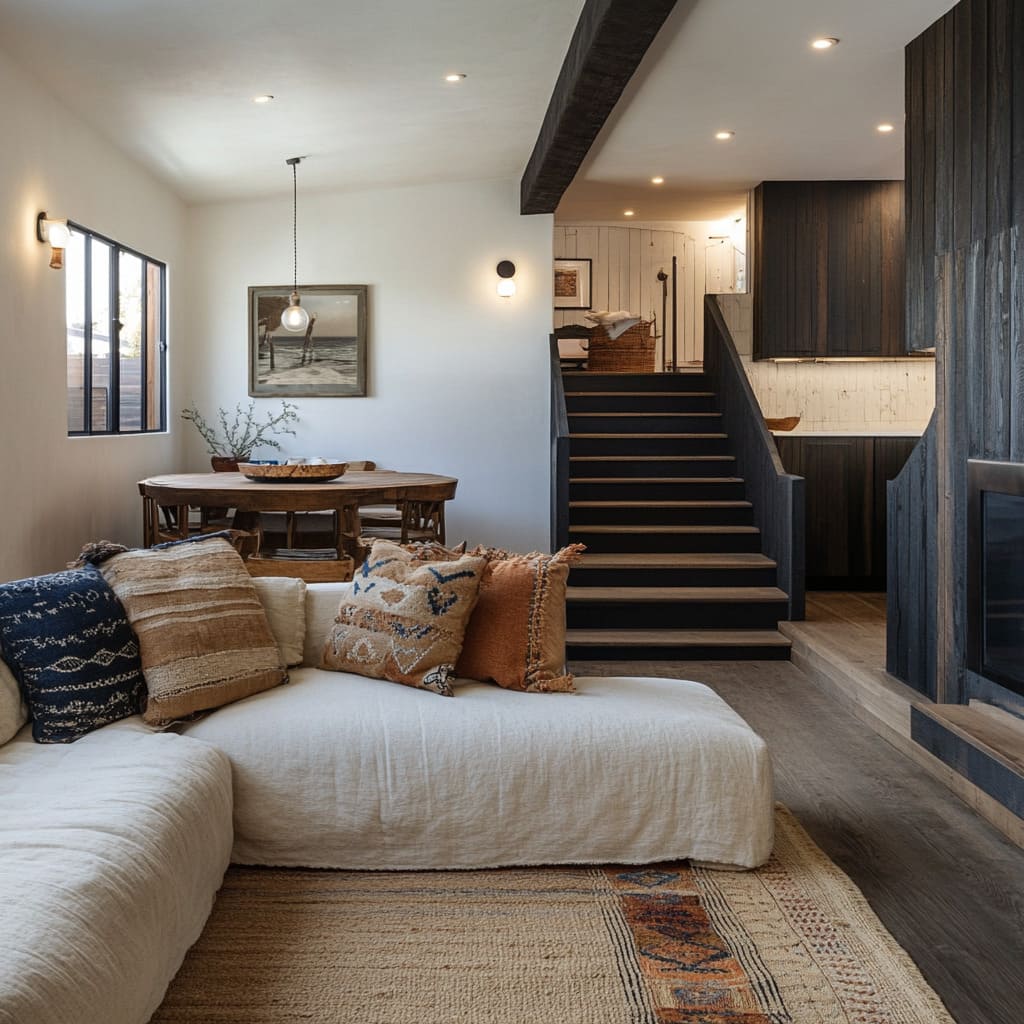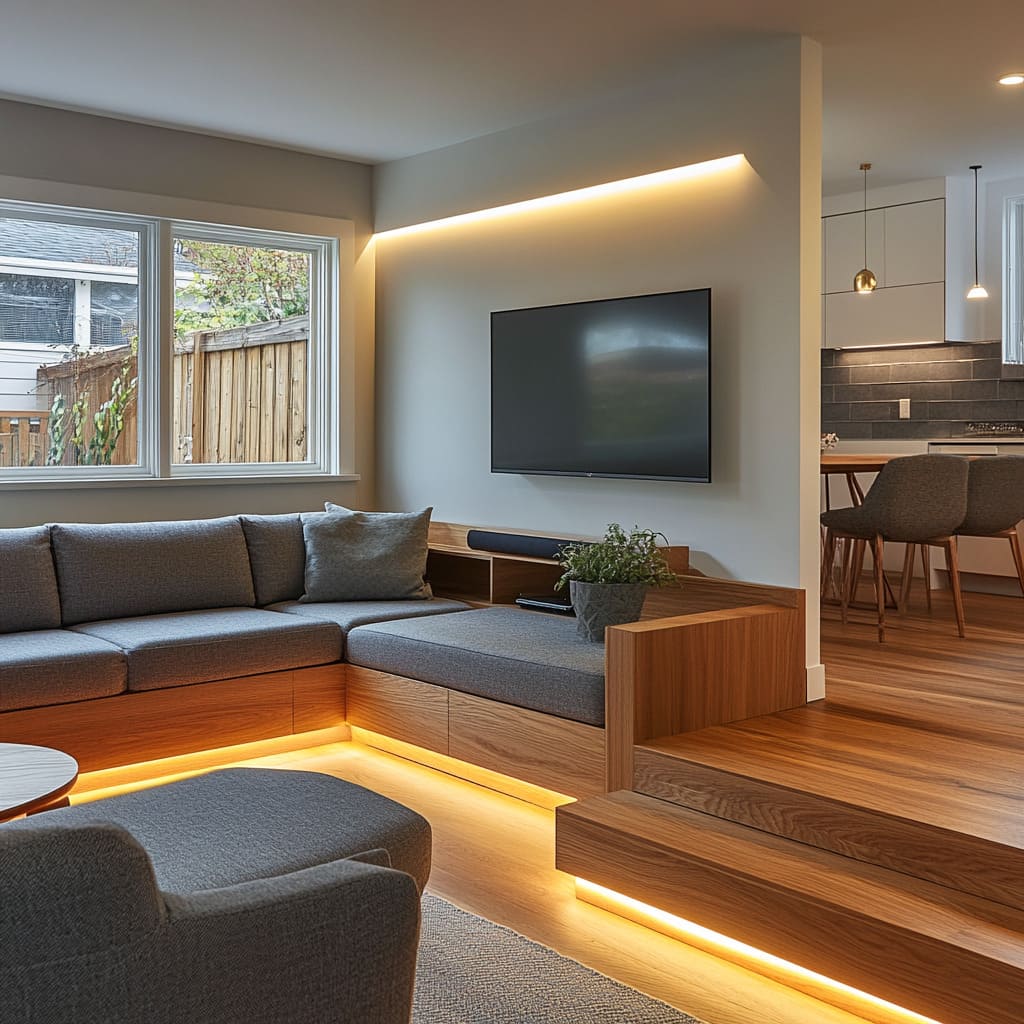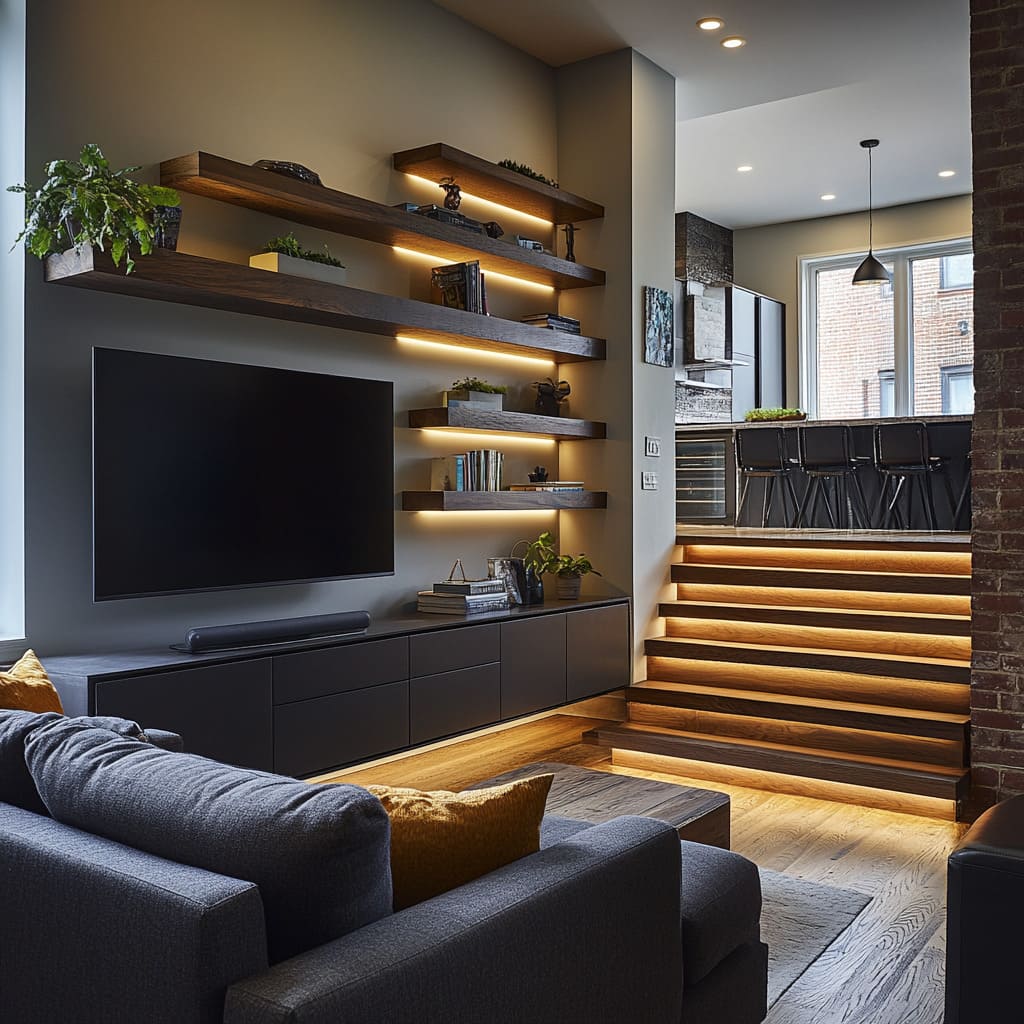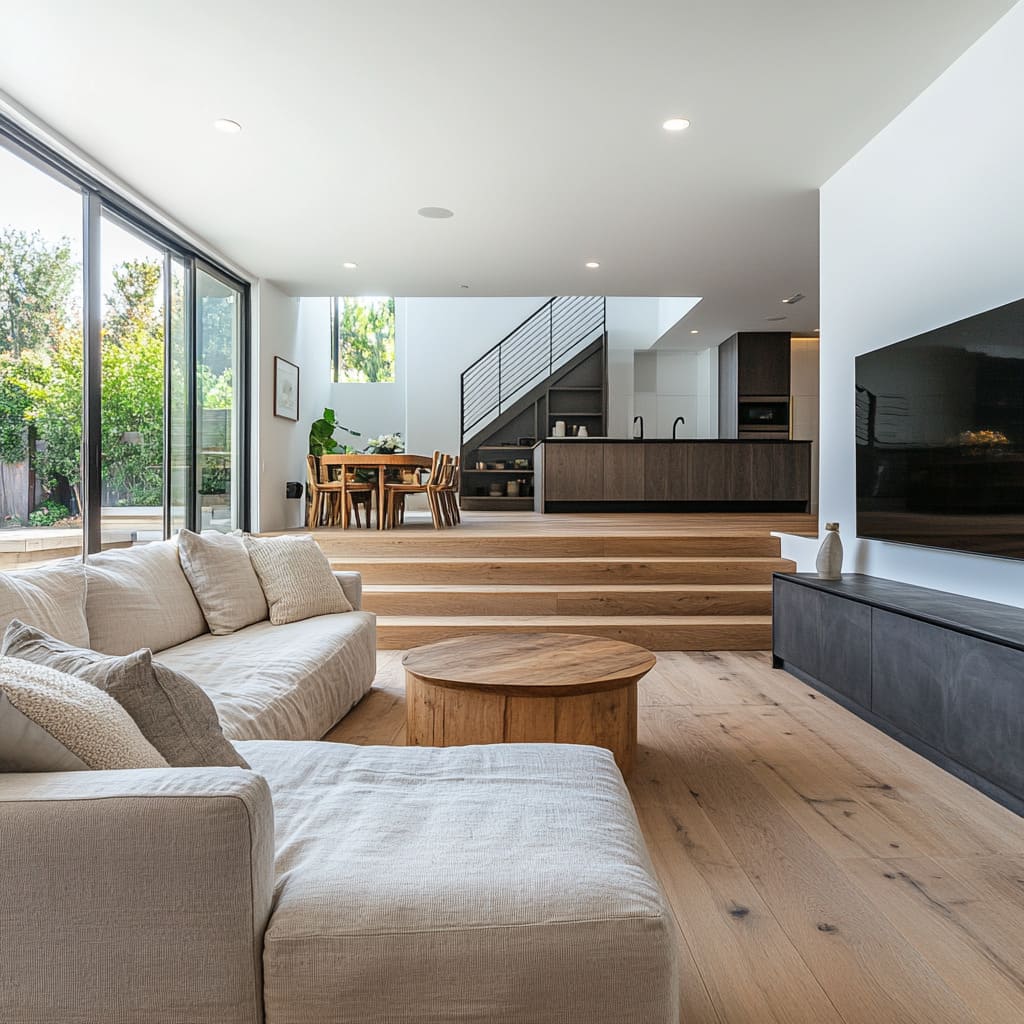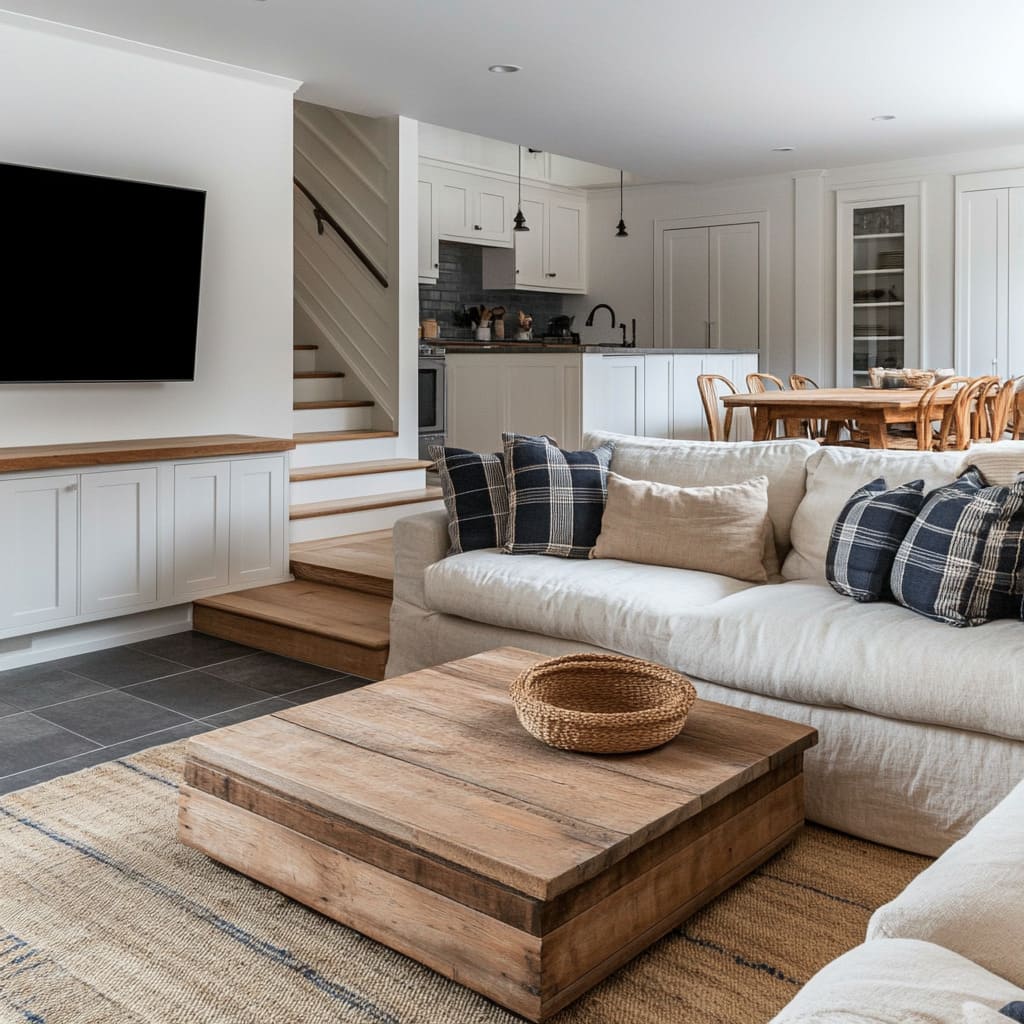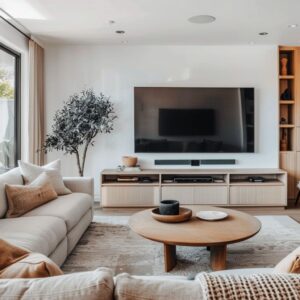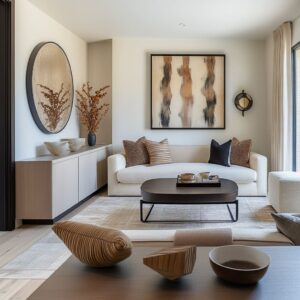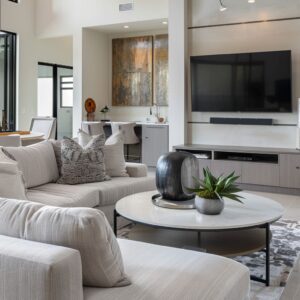A bi-level living room offers a unique blend of design and functionality, making it an ideal solution for homes that need to make the most of limited space. Commonly found in split-level homes, this layout creates a natural separation between different areas of the house, allowing for a more structured and organized flow without sacrificing the open-plan feeling that so many homeowners love.
Whether you’re working with a small footprint or just want to add some depth to your home’s layout, the bi-level approach is both practical and stylish
In smaller homes, space is always at a premium. That’s where the bi-level living room shines: it maximizes usable square footage while giving each area of the home its own distinct function.
By slightly elevating one space—whether it’s the dining area or the kitchen—you create an architectural interest that draws the eye and makes the home feel larger than it really is. This subtle layering also offers an opportunity to balance both style and everyday function, which is essential when decorating a split level living room in a modern suburban home.
The result is a living space that is both practical for family life and attractive for entertaining guests
Bi-Level Layout and Architecture
A well-designed split-level layout transforms the challenge of a small space into a benefit by introducing architectural division that enhances the overall flow of the home. A key feature of any bilevel home is the steps that subtly raise the kitchen or dining area, leaving the living room slightly recessed or sunken.
This separation between spaces offers a more dynamic floor plan compared to traditional single-level designs. These steps, sometimes featuring floating stairs or open risers, add visual interest and help create a feeling of openness, even in compact areas.
They provide a smooth transition between different levels while maintaining a cohesive look that’s essential for keeping a home feeling integrated rather than segmented
Floating stairs, for example, are not just functional—they’re visually light and don’t overpower the space. For smaller homes, this can make all the difference.
Open risers let light flow through, helping to keep both the upper and lower spaces bright and connected. The architectural trick of slightly elevating one space—often the dining area or kitchen—adds definition to each zone without making the home feel cramped.
Sightlines are another critical element in making these spaces work. Low-profile furniture plays a big role here.
A sectional sofa with a sleek, modern design can anchor the sunken living room without interrupting the flow between the living area and the upper levels. Keeping the furniture below eye level allows for unobstructed views across the bi-level living room, making the entire space feel larger and more inviting
The combination of smart space planning, thoughtful use of stairs, and an emphasis on clean sightlines makes bi-level living rooms perfect for small homes. By using these design principles, you can create a room that feels spacious and stylish, all while enjoying the benefits of architectural interest and clear division between functional spaces
Living Room Design Essentials
One of the most critical elements in creating a functional and inviting bi-level living room is selecting the right seating arrangement. Sectional sofas are an excellent choice for defining the seating area in these spaces, especially in a bi-level house where clear divisions between rooms are key.
A sectional not only provides ample seating but also helps to establish the boundaries of the living area without the need for walls or barriers
In a sunken lounge room, for example, a low-profile sectional can enhance the coziness of the space while keeping sightlines open between the living room and elevated kitchen or dining areas. The key is to choose a design that feels substantial yet doesn’t visually overwhelm the room.
A sectional with clean lines and minimal bulk is ideal for maintaining the openness that split level home living room ideas often aim for
Upholstery choices play a significant role in adding both comfort and style. Plush velvet adds a touch of luxury and warmth, making the space feel more intimate, while soft neutral fabrics can create a calming, versatile base that blends seamlessly with other elements in the room.
In smaller spaces, lighter upholstery can help make the room feel larger and airier. Additionally, mixing textures through throw pillows and blankets adds depth without crowding the space
Placement of the sectional is key for ensuring the room maintains a sense of flow. In bi-level homes, it’s important to place seating so that it faces the main focal point—whether that’s a TV or fireplace—while still allowing for easy movement between levels.
For example, if the living room is slightly recessed from the kitchen, positioning the sectional in a way that faces both the TV and the steps creates a harmonious connection between the different parts of the home
Centerpieces and Coffee Tables
When it comes to centerpieces in a split level home, the right coffee table can complete the look of the living room while serving both functional and aesthetic purposes. For a more compact area, a round coffee table provides contrast to the sharper lines of a sectional sofa, softening the overall feel of the room.
A round design also improves traffic flow, making it easier to move between levels or seating areas
Alternatively, a sleek rectangular or low-profile square coffee table adds a modern touch and maximizes surface space for decor or everyday items. The beauty of a rectangular table is its clean lines, which can echo the architecture of the split-level home, tying the room’s design together.
Material choices for these tables are equally important. For a more polished, luxurious feel, a marble-topped coffee table adds elegance, while a wood finish brings warmth and texture, making the space feel more grounded
Balancing functionality with artistic appeal is essential when choosing a centerpiece. A coffee table shouldn’t be purely decorative—it should offer practical features, like storage or ample surface space.
For example, a table with a lower shelf allows for storing books or magazines, keeping the top surface clutter-free while still providing plenty of room for display items like vases, bowls, or a decorative tray
Media Walls and Entertainment Centers
In any living room, the media wall often becomes the room’s focal point. Integrating the TV into a stylish media wall is essential, particularly in bi-level designs where the TV wall can serve as the visual anchor of the room.
Clean, architectural lines are key to achieving a polished look that complements the rest of the home’s layout. By using custom millwork, you can frame the TV, creating a seamless, built-in effect that doesn’t disrupt the overall flow of the room
For those designing a split level home, incorporating recessed TVs into the wall is a popular option. This approach not only minimizes clutter but also keeps the room looking streamlined and modern.
By recessing the TV, you avoid the visual bulk of a wall-mounted unit protruding into the living space. Surrounding the TV with simple, elegant paneling can elevate the design, adding depth and texture while keeping the look cohesive
Lighting plays a crucial role in enhancing the functionality and aesthetic appeal of the media wall. Recessed lighting along the edges of the wall or behind the TV can add a soft glow that highlights the feature without overwhelming the room.
This type of accent lighting creates a warm, inviting atmosphere, especially in the evenings when the living room becomes the heart of the home. For smaller spaces, storage is always a consideration.
Floating consoles are an excellent solution, offering both storage and display options while maintaining a sleek and minimal profile. These consoles can hold media equipment, books, or decorative items without taking up valuable floor space.
Additionally, lighting accents beneath floating consoles can add a modern touch, making the space feel both functional and stylish
In split level home designs, the media wall can also serve as a way to unify different parts of the living area. By choosing materials and finishes that complement the rest of the room—such as matching the cabinetry with the kitchen or dining area finishes—you create a sense of cohesion that ties the entire home together
Materials and Textures
When designing a bi-level living room, the choice of materials plays a pivotal role in setting the tone and personality of the space. A successful blend of natural materials like wood, stone, and metal with modern elements can elevate a room from ordinary to sophisticated, especially in small split-level homes where maximizing the visual impact is key
Natural wood is often at the heart of these spaces, providing warmth and an organic feel that contrasts beautifully with modern finishes. Whether it’s oak flooring, walnut cabinetry, or a rustic wooden coffee table, the grain and texture of wood introduce a timeless appeal.
Marble, on the other hand, offers a sleek, luxurious counterbalance to wood’s earthy tones. A marble coffee table or kitchen backsplash can instantly add refinement to the room without overwhelming the design.
This mix of materials not only defines modern sunken living rooms but also creates a harmonious blend of rustic charm and contemporary polish, making the home feel both comfortable and current
Metal accents, like those found in light fixtures or furniture legs, introduce a modern industrial edge to the room. Whether brushed brass, matte black, or polished chrome, these elements are understated yet impactful, lending a sleek touch to the overall design.
The key is to strike the right balance between these materials so that none feel out of place or overbearing. When renovating a split-level house, it’s essential to ensure that the materials chosen for the bi-level living room complement the rest of the home, maintaining a cohesive design language throughout
Incorporating different textures further enriches the room’s aesthetic. Velvet upholstery for sofas, woven rugs, and textured pillows are excellent ways to introduce softness and depth.
Velvet, especially in rich tones like navy or emerald, can add a luxe feeling to the room, while woven rugs ground the space, lending an element of rustic charm. These layers of texture create visual and tactile interest without overwhelming the small space, ensuring that the room feels intimate yet styled
The key to blending these materials is moderation. A balanced mix will help the space avoid feeling overly decorated.
Consider using natural wood for the primary furniture pieces, like shelving or tables, and introduce metal or stone in accents such as light fixtures or smaller décor items. Adding soft furnishings in varying textures like cotton, wool, and velvet will bring the room together in a way that feels inviting, without cluttering the aesthetic
Lighting to Accentuate the Space
Lighting is one of the most important elements in creating the right atmosphere in a bi-level family room. Thoughtfully placed lighting not only helps define the different areas of the space but also enhances the overall ambiance.
In bi-level living rooms, where the layout naturally has more depth due to the split-level architecture, layered lighting can make the space feel cozy and well-proportioned. Recessed lighting is ideal for creating a uniform layer of illumination across the room.
These lights are perfect for modern spaces as they blend into the ceiling, keeping the room’s design clean and uncluttered. They’re particularly effective in the lower levels of a sunken living room, where natural light might not reach as easily.
Soft, warm recessed lighting adds depth to these spaces without creating harsh shadows
Pendant lights offer an opportunity to bring focus to specific areas of the room, such as the dining table or kitchen island in a bi-level setup. Sleek, minimalist pendants made of metal or glass can act as both functional lighting and a stylish design element, complementing the rest of the materials in the room.
The key to using pendant lights effectively is to select designs that don’t overpower the space but still make a statement. Placing them at varying heights can also add visual interest and break up the space
Integrated lighting, such as under-shelf or under-stair lighting, can bring a soft, ambient glow to darker areas. This lighting style is especially useful in split-level designs to highlight the steps leading between levels, offering both functionality and style.
It also subtly draws attention to architectural features without being too obvious
Natural light, when available, is always a valuable asset, especially in smaller spaces. Large windows in the living room can flood the space with light during the day, creating an open and airy atmosphere.
However, balancing natural light with artificial sources is essential to maintain warmth and coziness as the sun goes down. Consider using soft, dimmable lighting throughout the room, allowing you to adjust the ambiance as needed, especially in the evening
Finally, balancing different types of lighting—ambient, task, and accent—is crucial in bi-level living room furniture placement. Recessed lights provide general illumination, pendant lights create focal points, and integrated lighting adds ambiance and highlights the room’s structure.
This combination will ensure the space is not only functional but also feels intimate, comfortable, and well-lit no matter the time of day
Color Palette Ideas for Stylish Bi-Level Living Rooms
The color palette in a bi-level living room plays a major role in setting the tone and atmosphere, especially in smaller spaces where every design choice counts. A neutral palette is often a reliable starting point, with colors like soft whites, greys, and pale blues acting as the foundation.
These muted tones provide a sense of calm and openness, crucial in bi-level living rooms where the architectural layering can otherwise make the space feel busy or confined. A neutral backdrop allows the different areas of the room—whether it’s the sunken living room or the elevated kitchen—to feel cohesive, even as they serve different functions
For those looking to introduce a bit more personality, accent colors such as deep navy, rich plums, or even a muted olive can be incorporated. These bolder tones add depth and sophistication without overwhelming the space.
The key is subtlety: use these colors sparingly in accent furniture, pillows, or art pieces to create contrast against the neutral backdrop. For example, in a split-level home living room, deep navy cushions or a bold accent chair can bring warmth and visual interest without making the room feel smaller or cluttered
Bold colors, when used thoughtfully, bring life to a room without taking over. One way to introduce such colors is through textiles—such as throws or rugs—that can easily be swapped out with the seasons.
In addition, incorporating accent decor, such as vases, framed art, or a single statement piece, can infuse the room with color while still maintaining the openness achieved by the lighter base tones
Kitchen and Dining Integration
In a bi-level home living room, the flow between the living, kitchen, and dining areas is essential to creating a unified and harmonious design. Since split-level homes often feature an elevated kitchen and dining area adjacent to the living room, it’s important to ensure that the design of these spaces complements each other.
Using similar materials and colors is key to blending these zones together without creating a jarring transition between levels
One of the best ways to achieve this seamless flow is by repeating key elements—such as wood, stone, or metal—throughout both the living room and the kitchen. For example, if the living room features natural wood accents, consider using the same wood finish for the kitchen island or dining table.
This helps create a sense of continuity, visually linking the two spaces together. Similarly, if the living room has a stone coffee table or side table, using the same stone material for a kitchen backsplash or island countertop can enhance this cohesive look
The color palette also plays an essential role in tying the living room and kitchen together. Neutral tones from the living room should carry over into the kitchen, but feel free to add small pops of complementary colors through kitchen accessories, bar stools, or dining chairs.
This ensures that while the rooms have their own distinct functions, they maintain a unified aesthetic. Designing functional yet stylish kitchen islands and dining areas is another important aspect when creating a balanced bi-level home.
A kitchen island can serve as both a workspace and a social hub. In terms of style, the island should reflect the overall design theme of the room while providing practical features like extra seating or storage.
Stools with finishes that match the living room furniture can help bridge the visual gap between the two spaces, while pendant lighting above the island can echo the lighting choices in the living room, bringing the entire layout together. Ultimately, whether you’re furnishing a sunken living room or planning the dining space in a bi-level home, harmony and flow between these areas ensure the home feels connected and thoughtfully designed.
By keeping materials, colors, and lighting cohesive, you can create a seamless and inviting open-plan layout that feels larger and more unified than its individual parts
Small Space Optimization Ideas
When designing a split-level living room, especially in smaller homes, space optimization is key. The unique architecture of split-level homes provides opportunities to maximize functionality without sacrificing style.
The trick lies in making smart design choices that allow you to utilize every inch efficiently while keeping the room feeling open and uncluttered
Built-in storage is one of the most effective ways to keep a bi-level living room organized and spacious. Wall-mounted shelves or floating media consoles not only save floor space but also provide plenty of storage for books, decor, and electronics.
Additionally, they keep the room looking clean and modern by reducing visual clutter. Custom-built cabinetry along one wall can serve multiple purposes—housing a TV, storing games or blankets, or even acting as a display case for cherished items
Multifunctional furniture is another must-have for small bi-level spaces. For instance, ottomans that double as storage bins or coffee tables that can be expanded or folded when not in use are excellent solutions.
Choosing furniture that offers multiple uses helps to conserve space while still providing the functionality needed for daily living. This approach can be especially helpful in bi-level homes where space may be divided among levels and must serve different purposes at various times of the day
Minimalist furniture choices can make a room feel larger. When selecting furniture for small split-level living rooms, opt for sleek designs that don’t overwhelm the space.
Low-profile sofas, open shelving units, and lightweight chairs are great options that maintain an airy feel while offering functionality. For example, in a mid-century modern sunken living room, furniture that features clean lines and minimal ornamentation keeps the space from feeling overcrowded while still emphasizing design
Decluttering is essential when working with limited space. Each piece of decor should be selected with intention to avoid making the room feel cramped.
A well-placed art piece, a few personal photos, or a statement light fixture can add personality without overwhelming the room. Keeping the color palette cohesive and minimizing the number of decorative elements allows the bi-level layout to shine without becoming visually chaotic
Connection to Nature
A successful split-level living room design often includes an emphasis on natural light and a connection to the outdoors. Large windows are a simple yet impactful way to bring natural light into the room, instantly making it feel more open and expansive.
In a bi-level home, windows strategically placed in both the sunken and elevated areas can flood the space with light, reducing the need for artificial lighting during the day and making the room feel larger than it is
Natural materials such as wood, plants, and organic textiles can further enhance the connection between the indoors and outdoors. Wood elements—whether in the form of flooring, shelving, or even accent furniture—add warmth and a sense of grounding to the space.
When paired with other organic materials like woven rugs, linen cushions, or a stone-topped coffee table, these elements create a tactile environment that feels welcoming and comfortable
Greenery can play a transformative role in connecting the room with its surroundings. Large potted plants placed strategically throughout the living space can soften sharp lines or industrial elements, bringing a sense of freshness and vitality.
Even in smaller spaces, smaller plants or hanging plants near windows or shelves can introduce this connection without taking up valuable floor space. The greenery not only enhances the visual appeal but also helps to improve air quality and create a more calming atmosphere
Incorporating natural materials and plants helps blend the interior with the outdoors, making the room feel more expansive and peaceful. Whether you’re using natural wood finishes or letting the sunlight stream through large windows, these design choices are key to creating a living room idea for split-level homes that feels both stylish and connected to nature
Practical Tips for Bi-Level Living Room Design
Designing a bi-level living room can be both exciting and challenging. While the split-level layout brings architectural interest and added depth, it’s important to avoid common mistakes that can detract from the flow and functionality of the space.
One of the most critical aspects of creating a successful design in a bi-level living room is maintaining a clear flow between the different areas. The steps that separate levels should feel like a natural part of the room’s layout, rather than a hindrance
To achieve this, be mindful of your bi-level living room furniture layout. Furniture should be arranged in a way that guides movement through the space.
Avoid blocking pathways between levels with bulky furniture. Instead, opt for low-profile, modular pieces that allow for easy navigation.
In a small split-level home, sectional sofas are particularly effective because they define the seating area without creating unnecessary barriers. A sleek sectional placed against one wall can frame the living room without intruding into the open floor space
Another common pitfall is prioritizing aesthetics over function, especially in compact homes. While it’s tempting to choose furniture and decor based solely on appearance, it’s essential to consider how each piece will work within the bi-level space.
Opt for multifunctional pieces that provide both style and practicality. For example, a coffee table with built-in storage or nesting tables that can be tucked away when not in use can help keep the room tidy without compromising on design.
By balancing both design and function, your bi-level living room can feel cohesive and livable, even in a smaller footprint
Decluttering is another essential strategy in decorating split-level living rooms. The open-plan nature of split-level homes means that every item is visible, which can make clutter more noticeable.
Keep the decor intentional—every piece should have a purpose. Built-in shelving, hidden storage, and streamlined furniture choices all contribute to a polished, organized look.
Rather than overcrowding the space with unnecessary items, focus on a few key pieces of decor that enhance the room’s character. This will ensure that the design remains clean and functional
Conclusion
Bi-level living rooms offer an array of benefits for small split-level homes. They provide architectural interest, maximize space, and create distinct zones without the need for traditional walls.
With thoughtful planning, a bi-level space can become a stylish and comfortable environment tailored to the way you live. Strategic use of materials, lighting, and smart bi-level living room decorating ideas ensure that even compact rooms feel spacious and inviting
Embrace the unique features of split-level architecture, and you can create a personalized, visually appealing home that feels much larger than its actual size. By balancing design with functionality, organizing the space thoughtfully, and maintaining clear flow between levels, a bi-level living room can be both practical and beautiful

